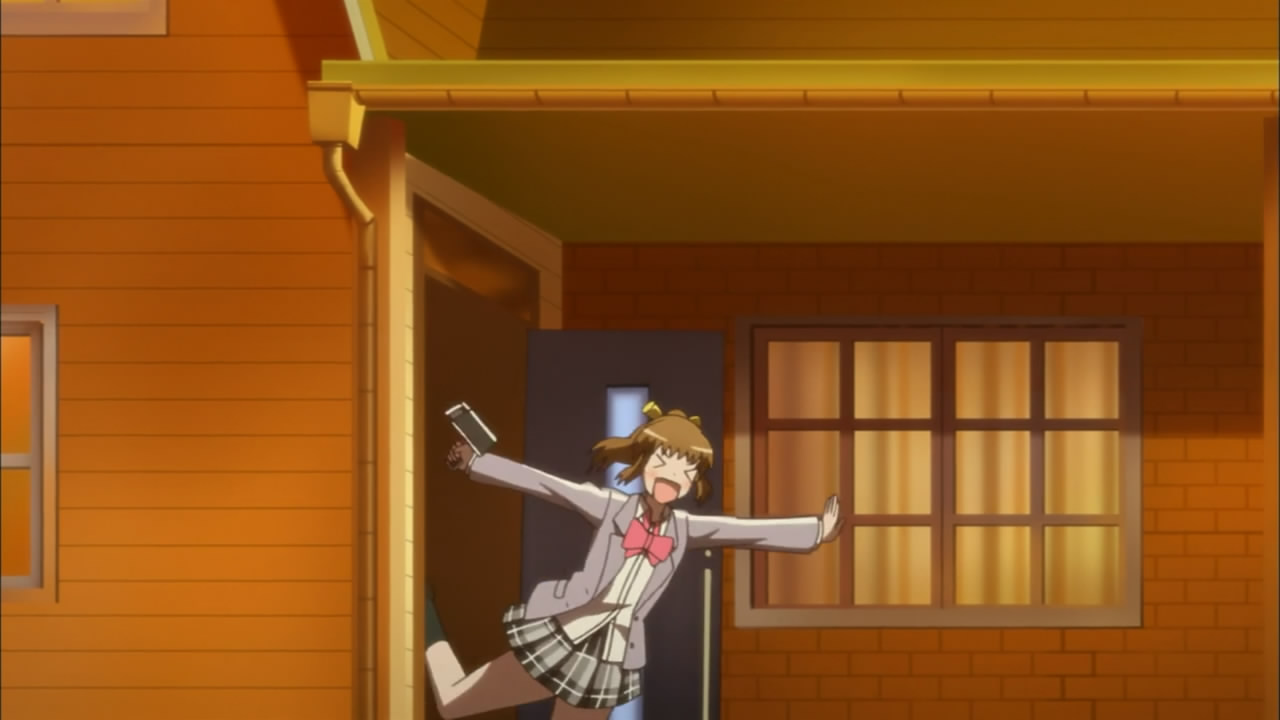Haiyore! Nyaruko-san Episode 9 References
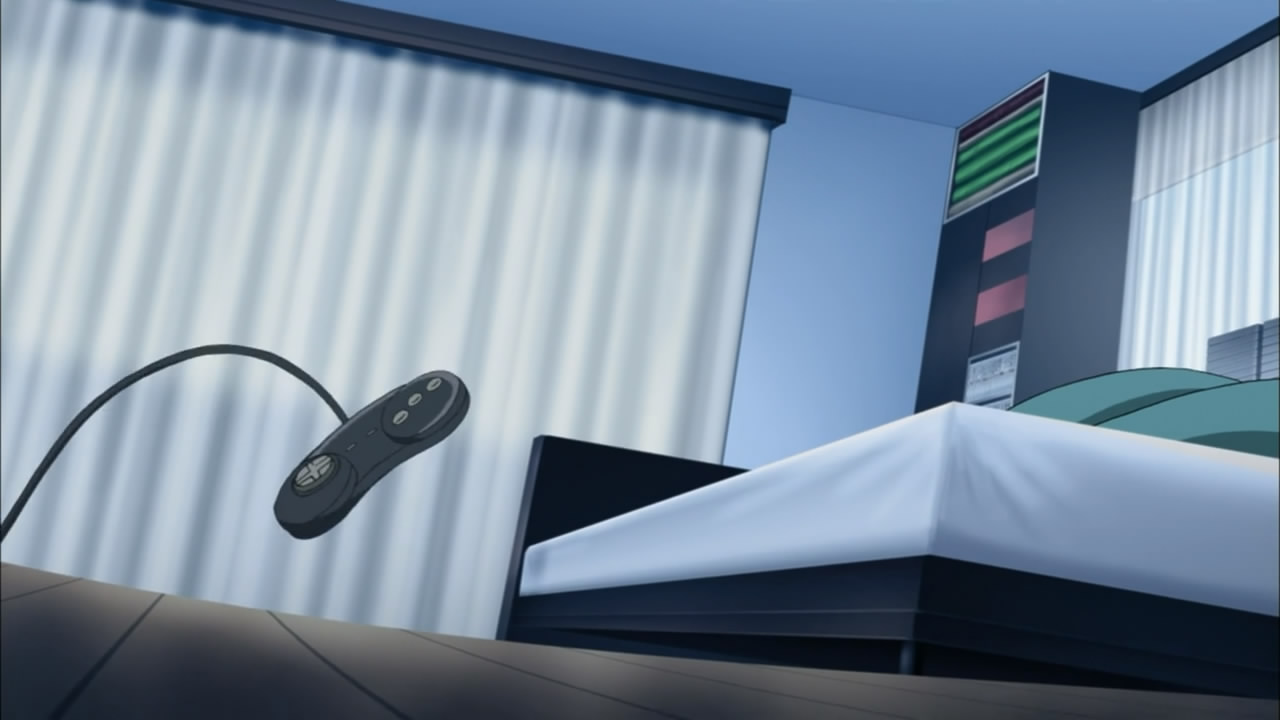
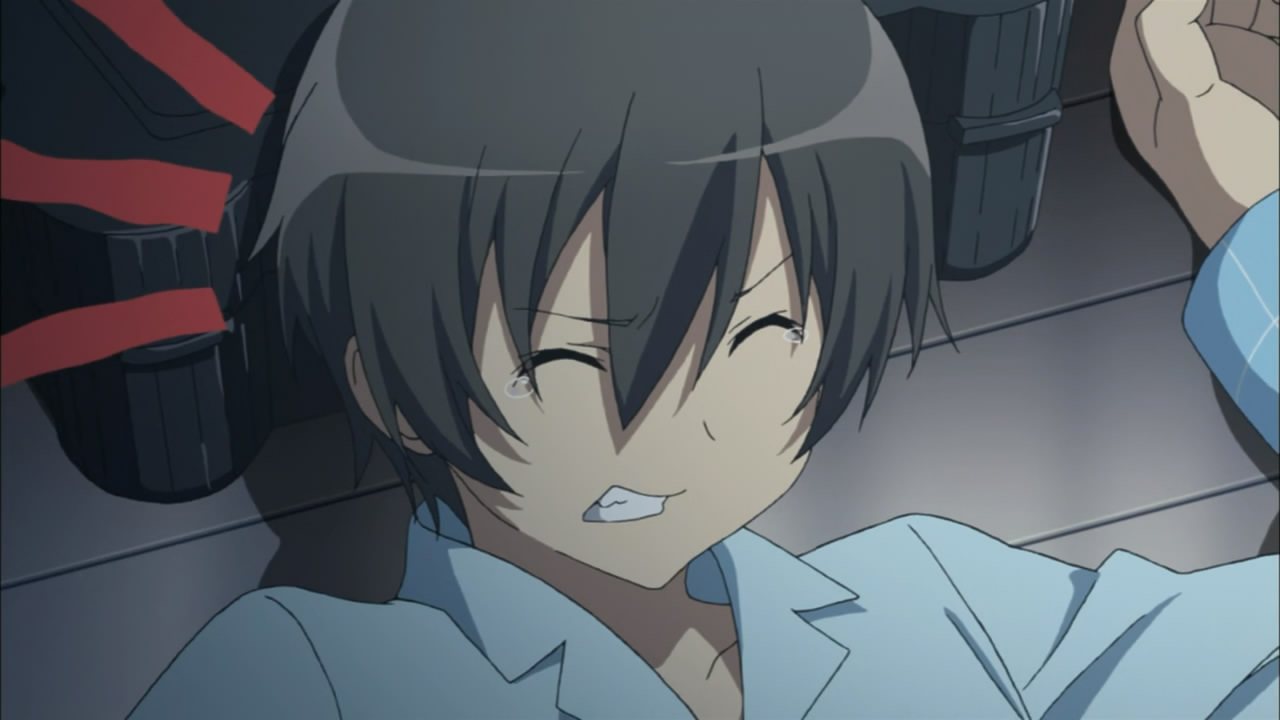
(0:48)
The controller and the video game console are referencing the Panasonic FZ-1 R·E·A·L 3DO Interactive Multiplayer (スリーディーオー), a video game console released by The 3DO Company in 1993.S1 This console is also referenced in episode 1 at 5:15. Image for reference:

Source of image: https://en.wikipedia.org/wiki/File:3DO-FZ1-Console-Set.png
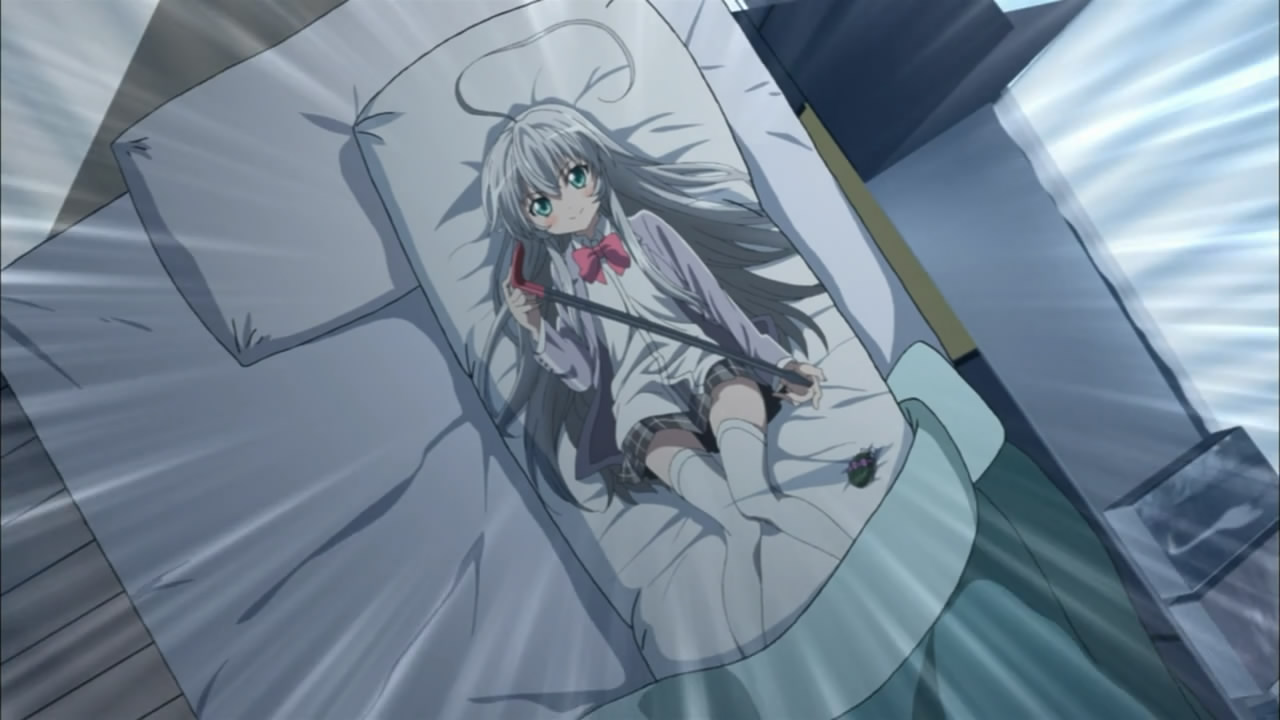
(0:55)
This pillow cover is based on a real pillow cover that was sold at Comiket 76 in August of 2009.S4 The illustration for the pillow cover was drawn by Koin (狐印), who does the artwork for the "Haiyore! Nyaruko-san" light novel series. Image for reference:
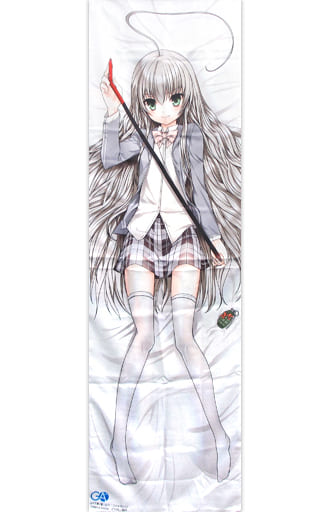
Source of image: https://www.suruga-ya.jp/product/detail/864012639
"If I do that, will I be able to crush Mahiro's heart in my fist?" (3:29)
This appears to be referencing a spell from the "Call of Cthulhu" RPG called "Clutch of Nyogtha", which allows the caster to crush the heart of a target character. Here is a description of the spell from the 5th edition of the "Call of Cthulhu" RPG for reference.S4
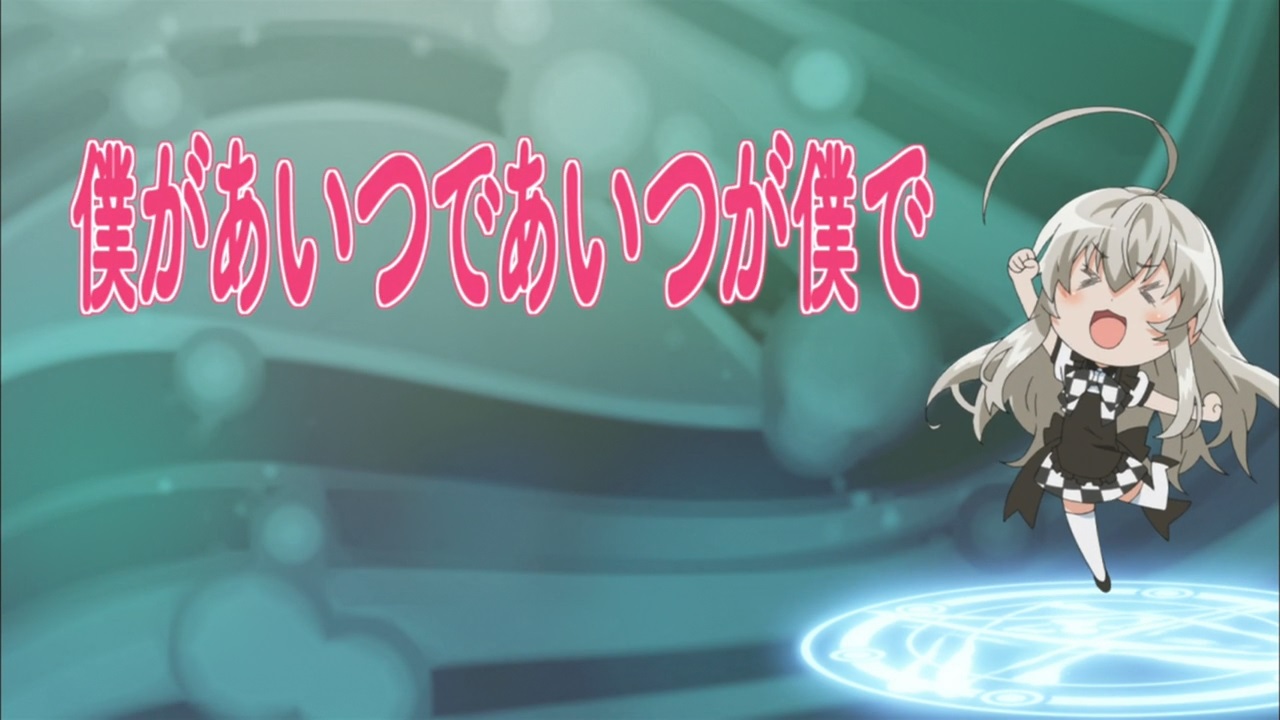
(3:51)
The title of this episode is "Boku ga Aitsu de Aitsu ga Boku de" (僕があいつであいつが僕で), which translates to "I am Her and She is me". This is referencing "Ore ga Aitsu de Aitsu ga Ore de" (おれがあいつであいつがおれで), "I am Her and She is me", a book written by Yamanaka Hisashi (山中恒) and published in 1980. The story is about a boy and a girl who mysteriously switch bodies.
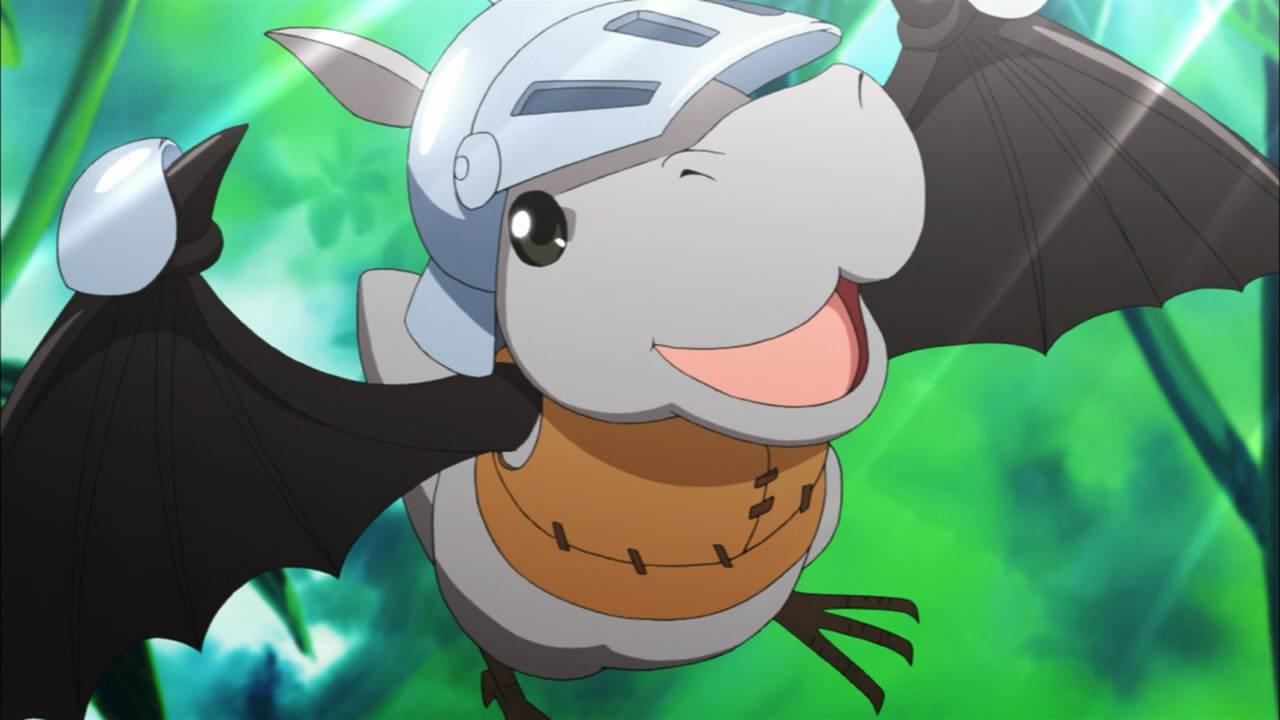
(4:21)
The armor that Shanta is wearing is based on the Acorn Mail (どんぐりメイル) from "Monster Hunter" (モンスターハンター), a series of video games released by CAPCOM (カプコン) starting from 2004.S1 Image for reference:
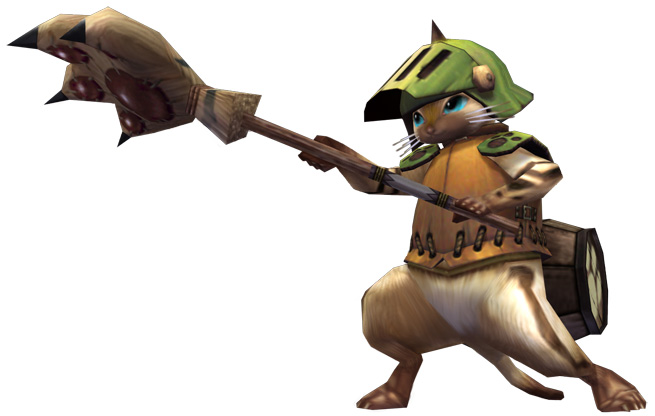
Source of image: http://monhanp2g.seesaa.net/article/89318211.html
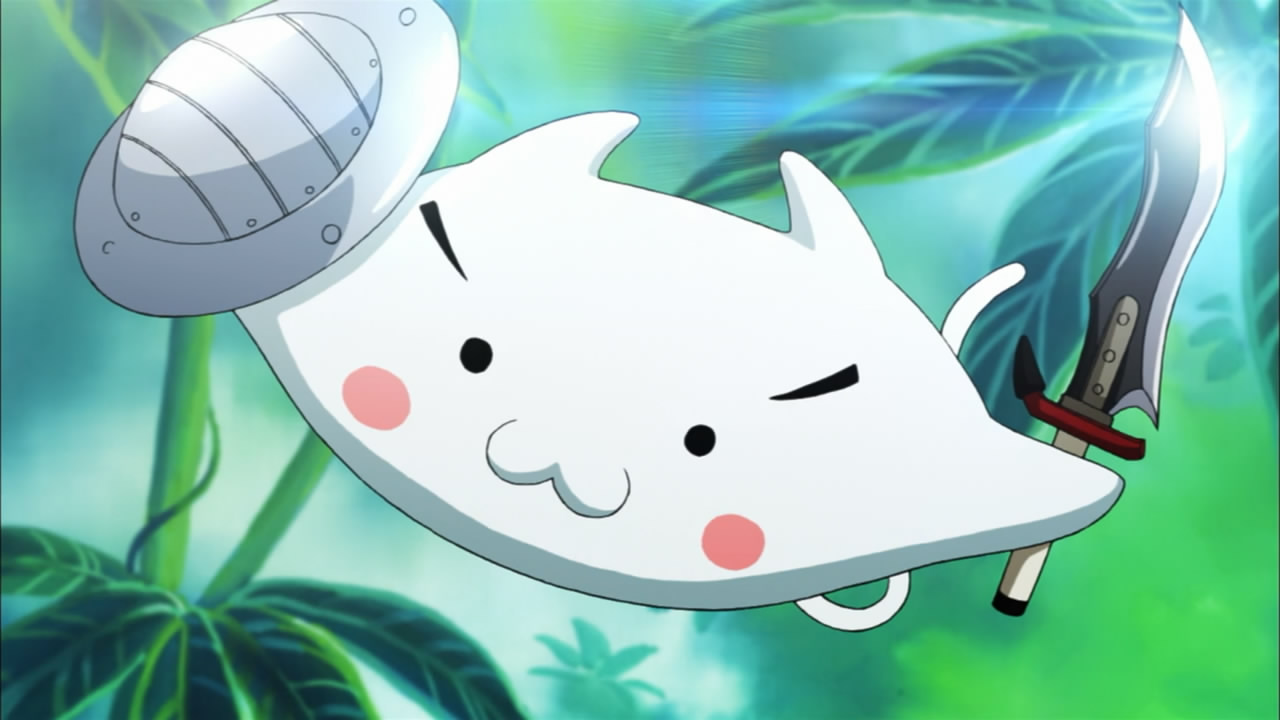
(4:23)
There are two references here:
* The white creature is the Twitter profile picture of Aisora Manta (逢空万太), the author of the "Haiyore! Nyaruko-san" light novel series. Screen capture for reference:

* The weapon Aisora Manta has equipped is based on the Odyssey (オデッセイ) from "Monster Hunter" (モンスターハンター).S1 Image for reference:
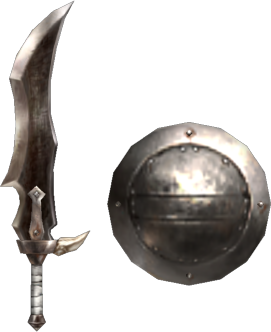
Source of image: http://monsterhunter.wikia.com/wiki/Odyssey
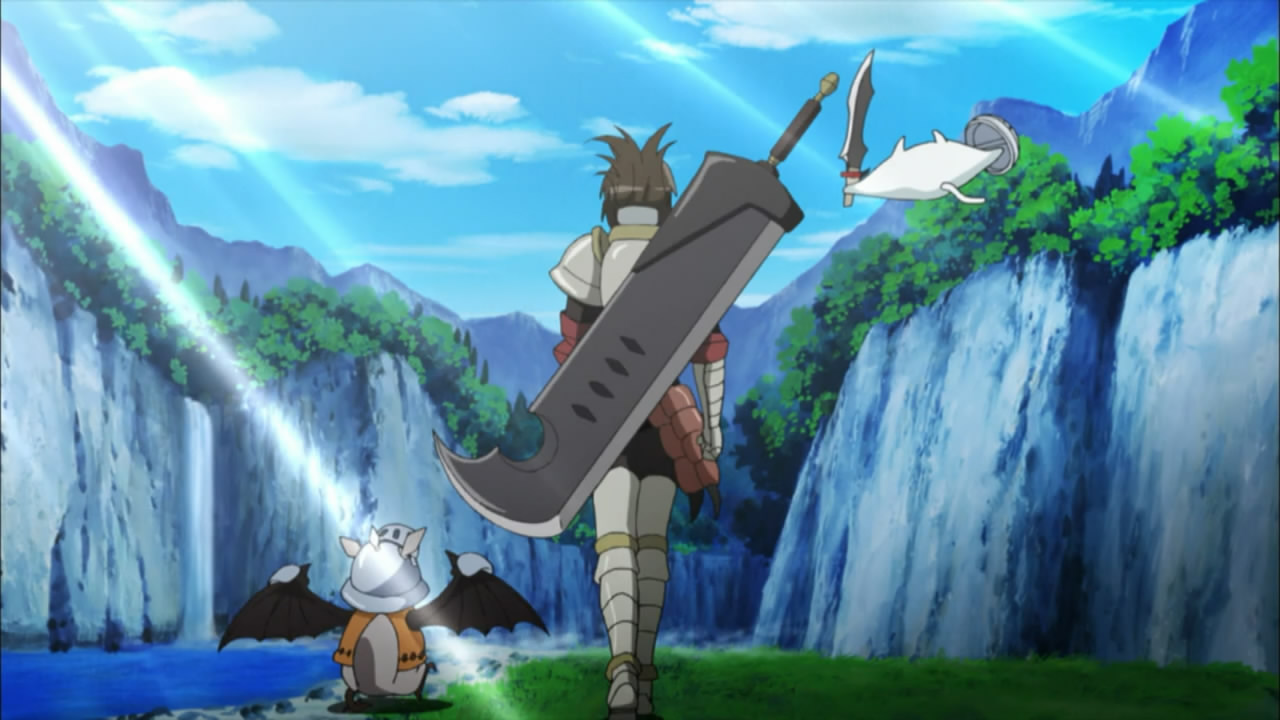
(4:23)
The sword Yoriko is carrying is based on the Buster Sword (バスターソード) from "Monster Hunter" (モンスターハンター).S1 Image for reference:

Source of image: http://monsterhunter.wikia.com/wiki/Buster_Sword
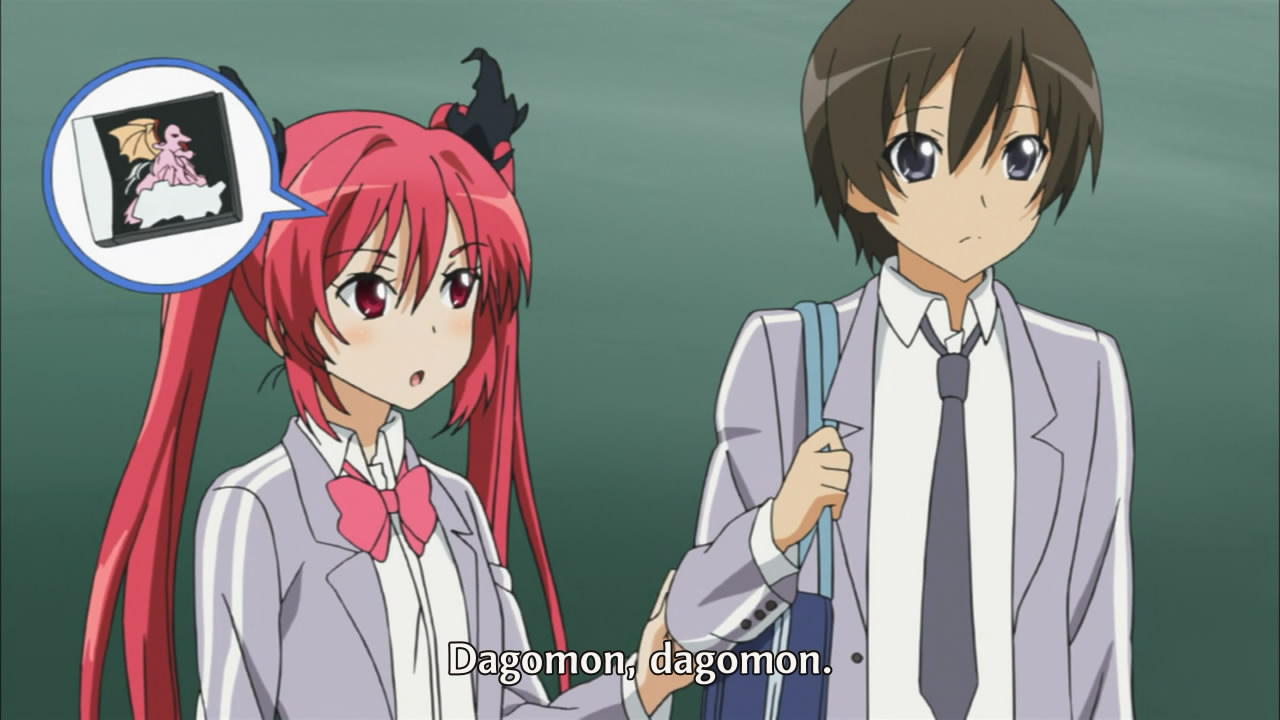
"Dagomon, dagomon." (4:33)
The name Dagomon (ダゴモン) and the appearance of the creature shown on the game box are based on Dagomon (ダゴモン) from "Digimon Adventure 02" (デジモンアドベンチャー02), an anime series that aired from 2000 to 2001.S4 Image for reference:
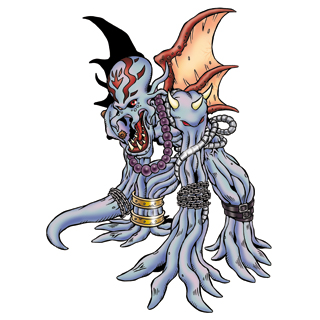
Source of image: http://digimon.net/cat-digimon-dictionary/04-ta/dagomon/index.html
On a related note, Dagomon itself is based on the Cthulhu Mythos. It first appears in episode 13 of "Digimon Adventure 02", and the title of this episode is "Dagomon no Yobigoe" (ダゴモンの呼び声), which translates to "The Call of Dagomon". This is referencing "Kuturufu no Yobigoe" (クトゥルフの呼び声), "The Call of Cthulhu", a short story written by H. P. Lovecraft and first published in 1928. Also, the appearance of Dagomon in the series is based on Cthulhu, and its name is based on Dagon, a sea dwelling creature and a servant of Cthulhu.S4

(5:02)
The appearance of this building is based on the Marui (丸井) department building in Kokubunji (国分寺).S1 Image for reference:

Source of image: http://itot2.jp/musako/22
In addition to the structural resemblance, there are multiple references:
* "△I△I" is displayed at the top of the building. This is referencing the Marui logo "OIOI".
* "SANKAKUI" is displayed on the side of the building. This is referencing the name "MARUI". "Maru" in Japanese means "circle", while "marui" means "circular". "Sankaku" in Japanese means "triangle", so to complement the circles in the logo being replaced with triangles, "MARU" was replaced with "SANKAKU". On a side note, "sankakui" is not a word in Japanese.
* The building has the text 「刻文路駅」 written on it, which can be read as "Kokubunji Eki", "Kokubunji Station". This is referencing how on the text 「国分寺駅」 (Kokubunji Eki) and "Kokubunji Stn." are written on the Marui department building.
* On a related note, the headquarters of Xebec (ジーベック), the studio that animates "Haiyore! Nyaruko-san", is located in Kokubunji nearby this Marui department building.S1
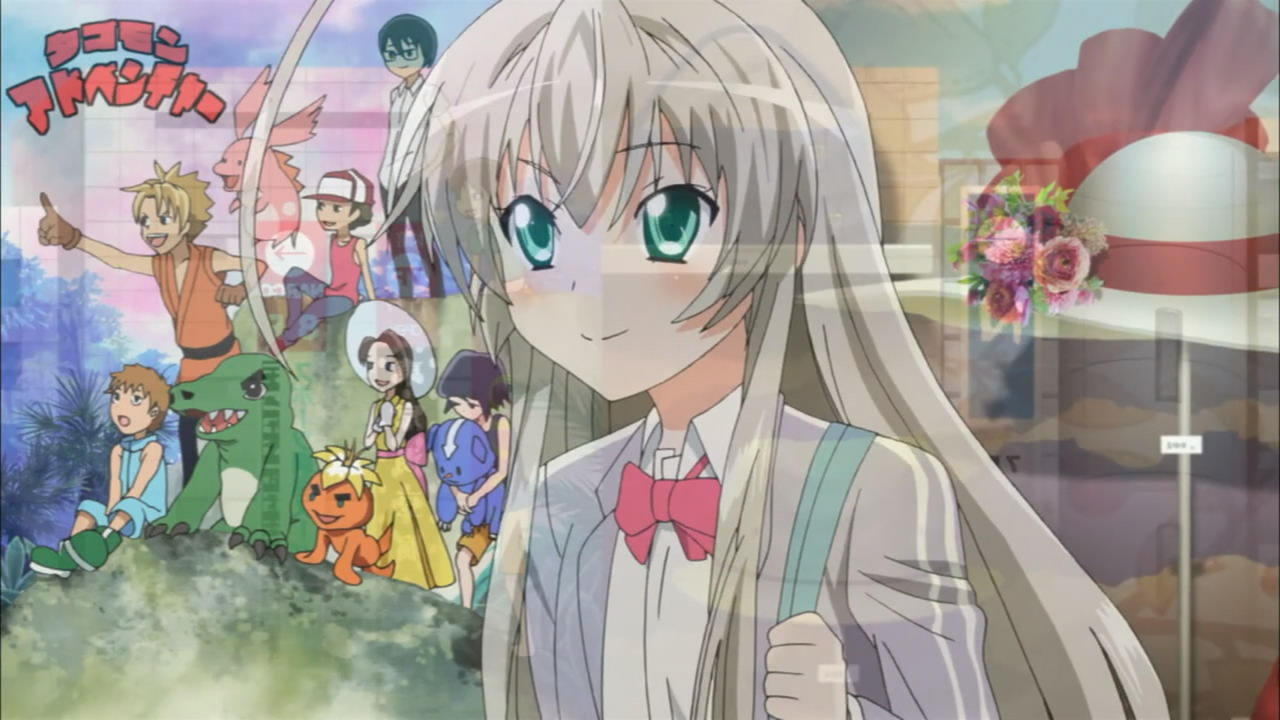
(5:05)
The Japanese text reads "Dagomon Adobenchaa" (ダゴモンアドベンチャー), "Dagomon Adventure". This is referencing "Dejimon Adobenchaa" (デジモンアドベンチャー), "Digimon Adventure", an anime series that aired from 1999 to 2000. In addition, the appearance of the poster is referncing promotional artwork from this series.S1 Image for reference:
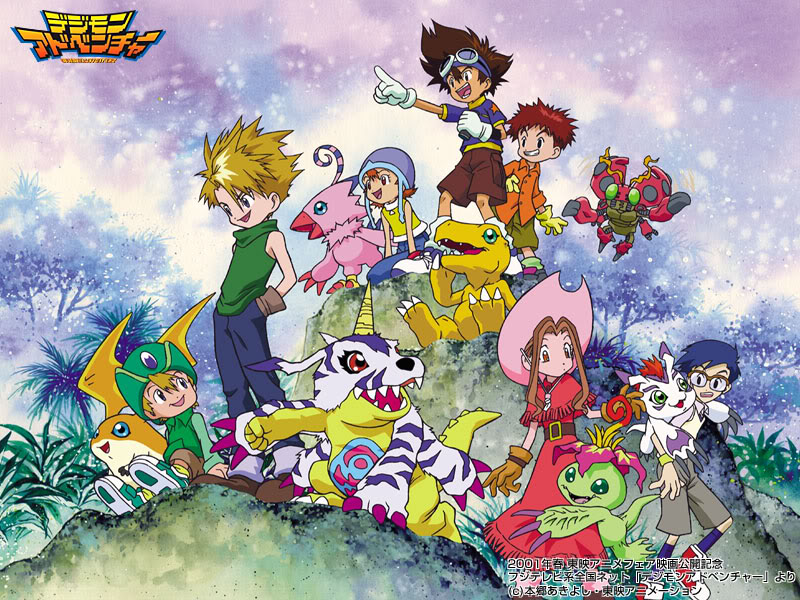
Source of image: http://www.adv-dream.net/images.html
"The window! The window shopping!" (5:09)
The Japanese line is "Za uindou! Za uindou shoppingu!" (ザ ウィンドウ!ザ ウィンドウ ショッピング!). This is referencing "Dagon", a short story written by H. P. Lovecraft and first published in 1919. The last words written in this story are "The window! The window!". In the Japanese translation of this story, the last words written are "Mado ni! Mado ni!" (窓に!窓に!).
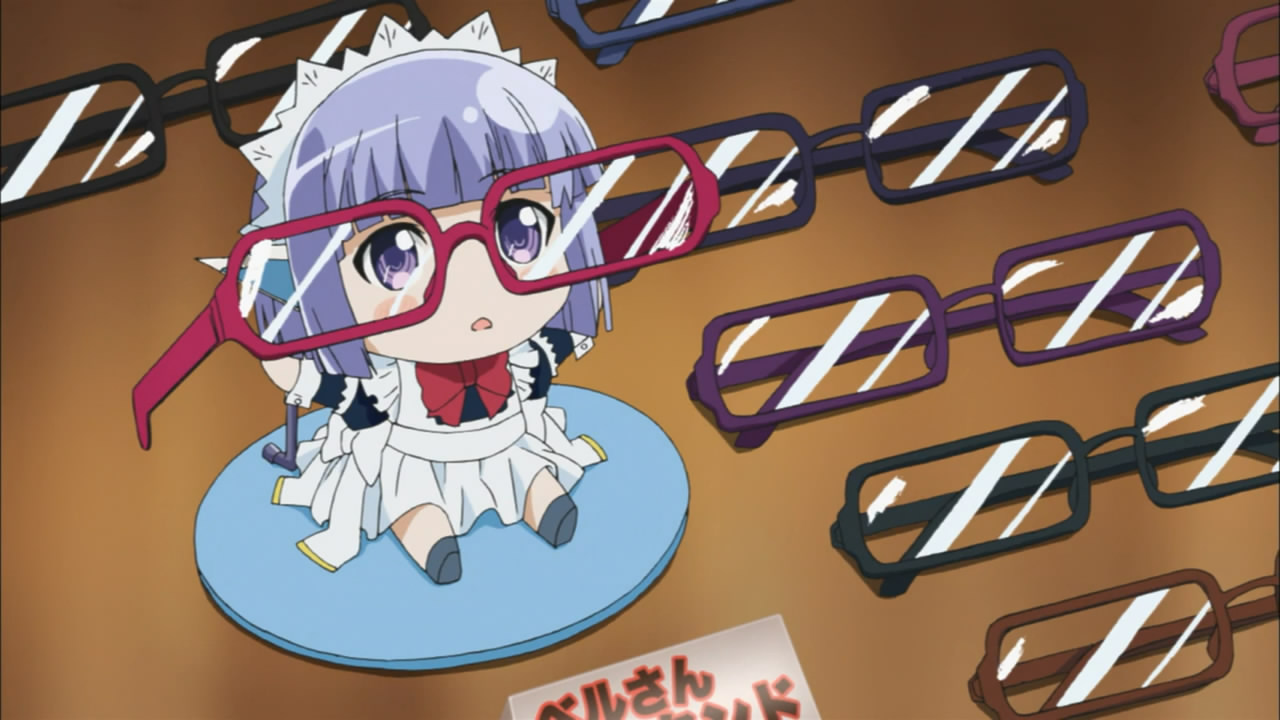
(5:34)
The blue haired girl, who also appeared in episode 1 at 8:27, is Berutein (ベルテイン) from "Miyama-san chi no Berutein" (深山さんちのベルテイン), "The Miyama Household's Berutein", another light novel written by Aisora Manta (逢空万太). Here is the cover of the first volume for reference:

Source of image: http://ga.sbcr.jp/novel/miyama/01.html
"I'm wet." (5:51)
The Japanese line is "Nureru!" (濡れるッ!). This is referencing the same line said by Busujima Saeko (毒島冴子) in chapter 17 of volume 4 of "Gakuen Mokushiroku HIGHSCHOOL OF THE DEAD" (学園黙示録 HIGHSCHOOL OF THE DEAD), "Apocalyptic Academy Highschool of the Dead", a manga series written by Satou Daisuke (佐藤大輔) and published starting from 2006. She also says this line in episode 9 of the anime adaptation of this series, which aired in 2010. Images for reference:
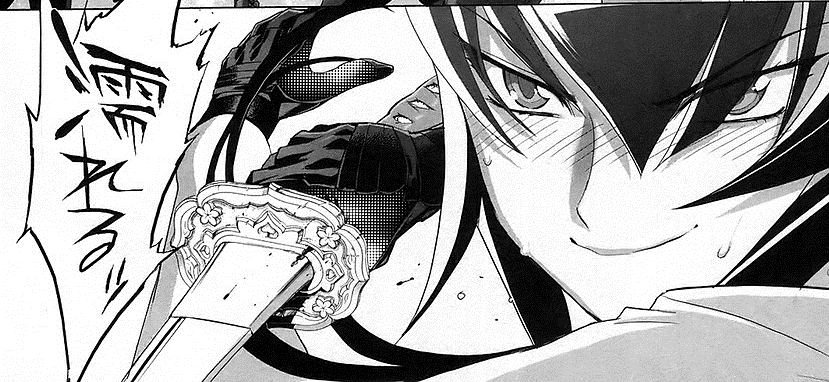
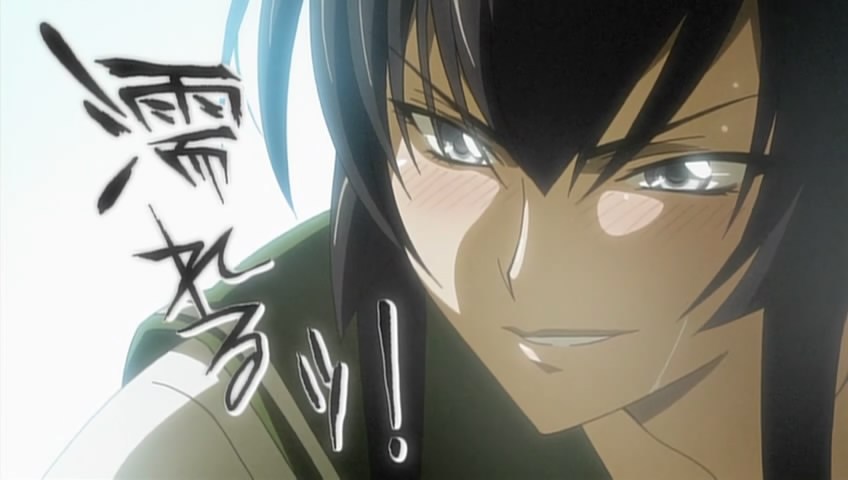
"That's totally impossible!" (5:57)
The Japanese line is "Bucchake ariemasen yo" (ぶっちゃけありえませんよ). This is referencing a line in the lyrics to "DANZEN! Futari ha Purikyua" (DANZEN! ふたりはプリキュア), "Absolutely! We are Pretty Cure", a song sung by Gojou Mayumi (五條真由美) and released in 2004.S1 This song is the opening theme song to "Futari ha Purikyua" (ふたりはプリキュア), "We are Pretty Cure", an anime series that aired from 2004 to 2005. The original line goes, "Bucchake arienai" (ぶっちゃけありえない), which has the same meaning as above.
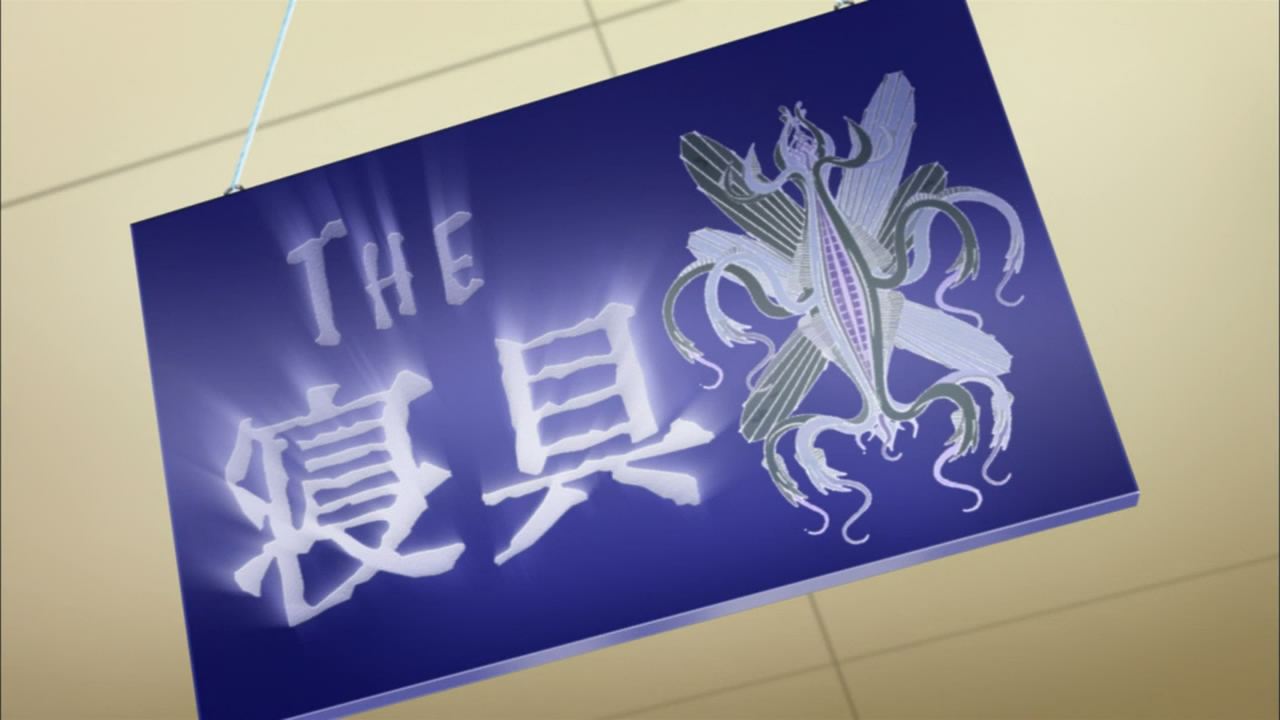
(6:49)
The sign reads "The 寝具", pronounced as "The Shingu", and means "The Bedding". This is a pun on the pronunciation of the Japanese word 「寝具」 (shingu) and the English word "thing". Thus the sign can read as "The Thing". There are two references here:
* This is referencing Elder Things, a species of creature in the Cthulhu Mythos. In addition, the creature that appears on the sign is an Elder Thing.S4 In "The Dreams in the Witch House", a short story written by H. P. Lovecraft and first published in 1933, Elder Things are described as follows:
"They represented some ridged, barrel-shaped object with thin horizontal arms radiating spoke-like from a central ring, and with vertical knobs or bulbs projecting from the head and base of the barrel. Each of these knobs was the hub of a system of five long, flat, triangularly tapering arms arranged around it like the arms of a starfish—nearly horizontal, but curving slightly away from the central barrel."In "At the Mountains of Madness", a story written by H. P. Lovecraft and first published in 1936, Elder Things are further described as follows:
"Like a barrel with five bulging ridges in place of staves. Lateral breakages, as of thinnish stalks, are at equator in middle of these ridges. In furrows between ridges are curious growths. Combs or wings that fold up and spread out like fans."* This is referencing "The Thing", an American movie released in 1982. In addition, the appearance of the sign is referencing promotional artwork for this movie. Image for reference:
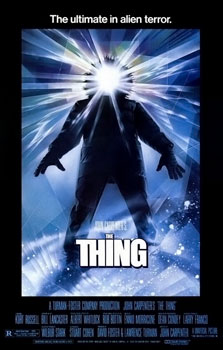
Source of image: https://en.wikipedia.org/wiki/File:ThingPoster.jpg
On a related note, this movie is set in Antarctica, and fossils of the Elder Things are found in Antarctica in "At the Mountains of Madness", a short story written by H. P. Lovecraft and first published in 1936.
"Fall, you flies!" (8:14)
The Japanese line is "Ochiro! Katonbo!" (落ちろ!蚊トンボ!). This is referencing the same line said by Paptimus Scirocco (パプテマス・シロッコ) in episode 11 of "Mobile Suit Zeta Gundam" (機動戦士Ζガンダム), an anime series that aired from 1985 to 1986.S1 On a related note, the voice actor who voices Nodens, Shimada Bin (島田敏), also voices Paptimus.S2
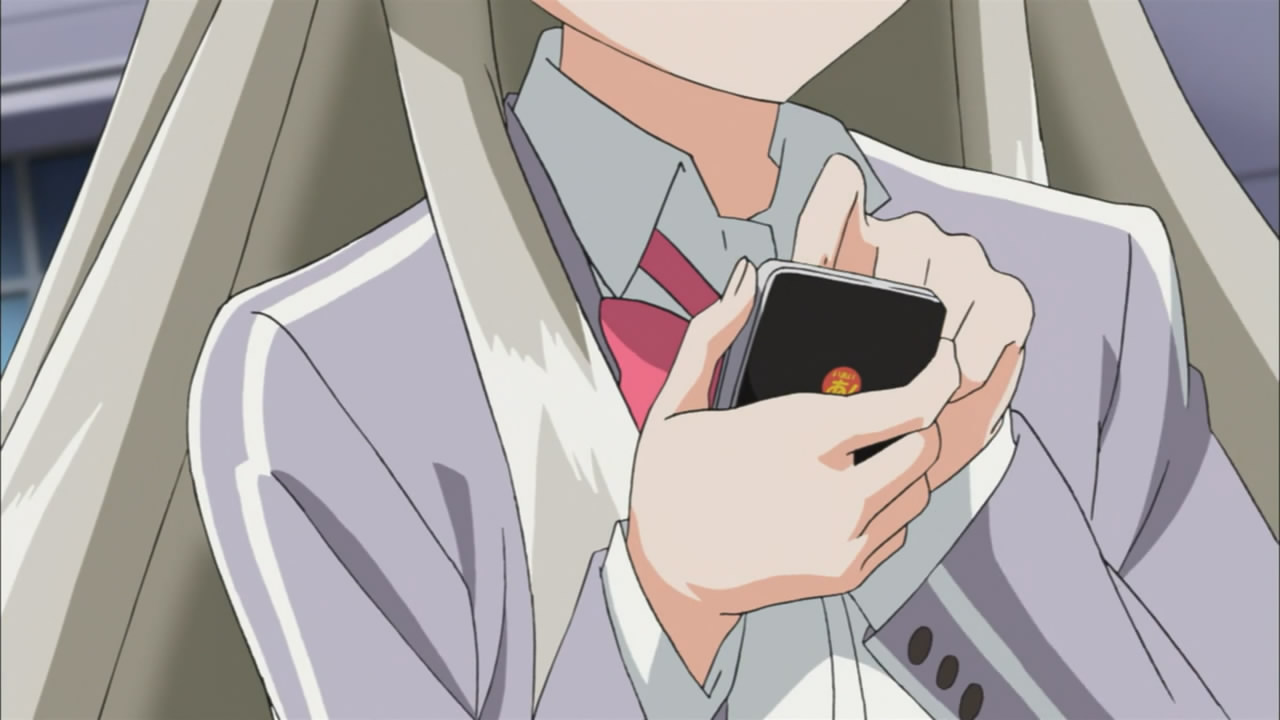
(8:23)
There are two references here, both repeats from episode 1 at 3:20.
* The small red logo on Nyaruko's phone is referencing "Azumanga Daioh" (あずまんが大王), a manga series written by Azuma Kiyohiko (あずまきよひこ) and published from 1999 to 2002. In particular, the yellow text within a red speech bubble appears to be referencing the same color scheme used for the title of the anime adaptation of this series that aired in 2002. In addition, the big 「あ」 character within the speech bubble is referencing how at times in this series characters have been depicted with a speech bubble containing the character 「あ」. Images for reference:
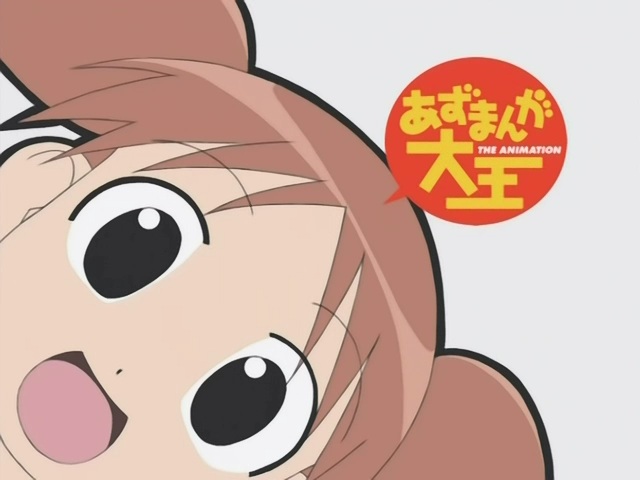
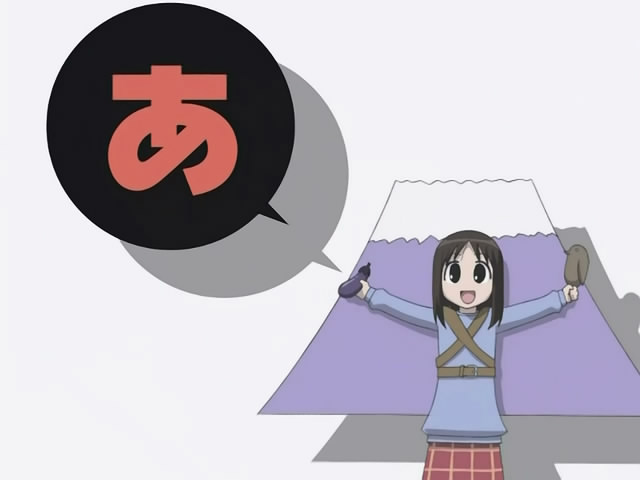
* The text within the logo reads "Ia Ia!" (いあいあ!). "Iä" is a term that is used in the Cthulhu Mythos, often in relation to the fantastic creatures that appear in the mythos. In "The Shadow Over Innsmouth", a story written by H. P. Lovecraft and first published in 1936, a chant using the term goes as follows:
"Iä! Iä! Cthulhu fhtagn! Ph’nglui mglw’nafh Cthulhu R’lyeh wgah-nagl fhtagn"
"Allow me to explain." (8:35)
The Japanese line is "Setsumei shiyou" (説明しよう). This is referencing "Yatterman" (ヤッターマン), an anime series that aired from 1977 to 1979. During an episode, occasionally the narrator, or sometimes Boyakkii (ボヤッキー), another character in the series, will say "Setsumei shiyou" (説明しよう), "Allow me to explain", and interrupt the episode to explain something to the viewer about the current situation. This also occurs in the remake of "Yatterman" which aired from 2008 to 2009.S3
"There is a realm of the subconscious deeper than dreams, where all Earthings are connected. That is the Dreamland." (8:37)
First mentioned in episode 3, the Dreamland is a fictional location in the Cthulhu Mythos that humans can enter when they fall asleep. In "The Dream-Quest of Unknown Kadath", a story written by H. P. Lovecraft and published in 1943, the Dreamland is called "the world of all men's visions".
Background music (9:37)
The song that plays at this time is "Watashi Majikaru" (わたし・魔ジカル), "I'm Magical", a song sung by Kouda Mariko (國府田マリ子) and Hisakawa Aya (久川綾), the voice actors of Luhi and Yoriko respectively.S3 The song was released on "Jashin Kyoku Tachi" (邪神曲たち), "Evil God Song Collection", a set of music discs containing songs sung by the cast of "Haiyore! Nyaruko-san" and the original soundtrack for the series released in 2012.
(9:40)
The line at this time goes as follows:
「私の使命は重力に・・・もとい、地球のエンタメに魂を引かれた人々の解放することだ」This is referencing a line said by Paptimus Scirocco in episode 21 of "Mobile Suit Zeta Gundam" (機動戦士Ζガンダム).S1 His original line goes as follows:
"Watashi no shimei ha juuryoku ni... motoi, chikyuu no entame ni tamashii wo hikareta hitobito no kaihou suru koto da"
"It is my mission to free people whose souls are being pulled by gravity... I mean, by Earth's entertainment!"
「私の使命は、重力に魂を引かれた人々を解放することだと思っている」Again, this is referencing how the voice actor who voices Nodens, Shimada Bin (島田敏), also voices Paptimus.
"Watashi no shimei ha, juuryoku ni tamashii wo hikareta hitobito wo kaihou suru koto da to omotteiru."
"I believe it is my mission to free people whose souls are being pulled by gravity."
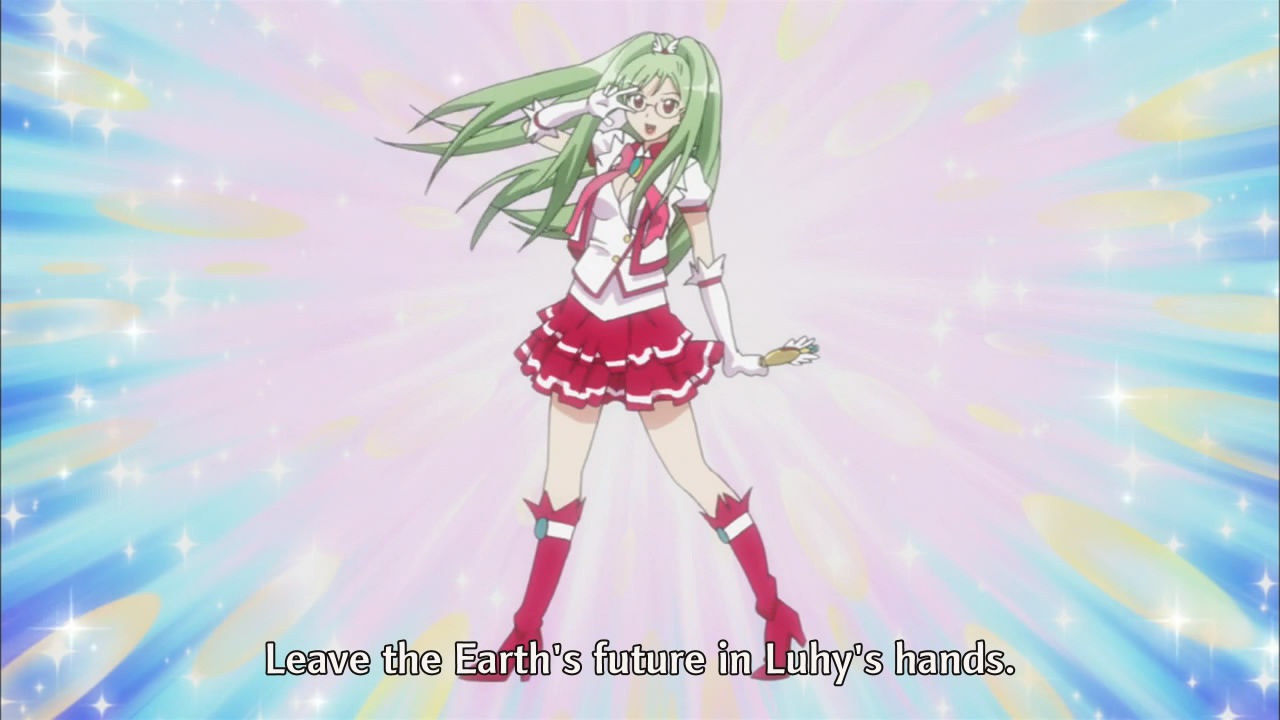
(10:04)
There are three references here:
* The line at this time goes as follows:
「魔法少女イーベルルーヒー、華麗にデビュー!地球の未来はルーヒーに、お任せ!」This is referencing a line said by Ruie Ruru (流家ルル) on page 16 of volume 1 of "Makai Shoujo Ruruie Ruru" (魔海少女ルルイエ・ルル), "Girl From the Demonic Sea Ruruie Ruru", a light novel series written by Hazawa Kouichi (羽沢向一) and published in 2010. The original line goes as follows:
"Mahou shoujo Iiberu Ruuhii, karei ni debyuu! Chikyuu no mirai ha Ruuhii ni, omakase!"
"Magical Girl Luhy Hiver has gorgeously debuted! Leave the future of Earth to Luhy!"
「魔法の天使ルルイエ・ルル、華麗に浮上(デビュー)!地球の未来はルルにおまかせよっ」Luhy appearing out of a column of water is also referencing how Ruru appears out of a column of water when she says this line.S4
"Mahou no tenshi Ruruie Ruru, karei ni debyuu! Chikyuu no mirai ha Ruru ni omakase yo!"
"Magical Angel Ruruie Ruru has gorgeously debuted! Leave the future of Earth to Ruru!"
* Luhy calls herself "Iiberu Ruuhii" (イーベル・ルーヒー), "Hiver Luhy". This is referencing Yumi Francois (ユミ・フランソワ) from "Uchuu no Kishi Tekkaman Bureedo Tsuu" (宇宙の騎士テッカマンブレードII), "Space Knight Tekkaman Blade II", an anime series released from 1994 to 1995. In the series, Yumi transforms into "Tekkaman Iiberu" (テッカマンイーベル), "Tekkaman Hiver". On a related note, the voice actor who voices Yumi, Kouda Mariko (國府田マリ子), also voices Luhy.
* Luhy's outfit is the same as the one she wears on the cover of "Haiyore! Nyaruko-san GX ~Feitaru Atorakushon~" (這いよれ!ニャル子さんGX ~フェイタルアトラクション~), "Crawl! Nyaruko GX ~Fatal Attraction~", a drama CD released in 2011.S4 Image for reference:
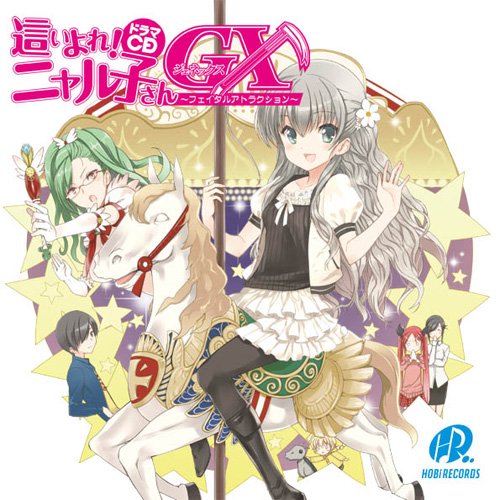
Source of image: http://www.amazon.co.jp/dp/B004TPZPC0
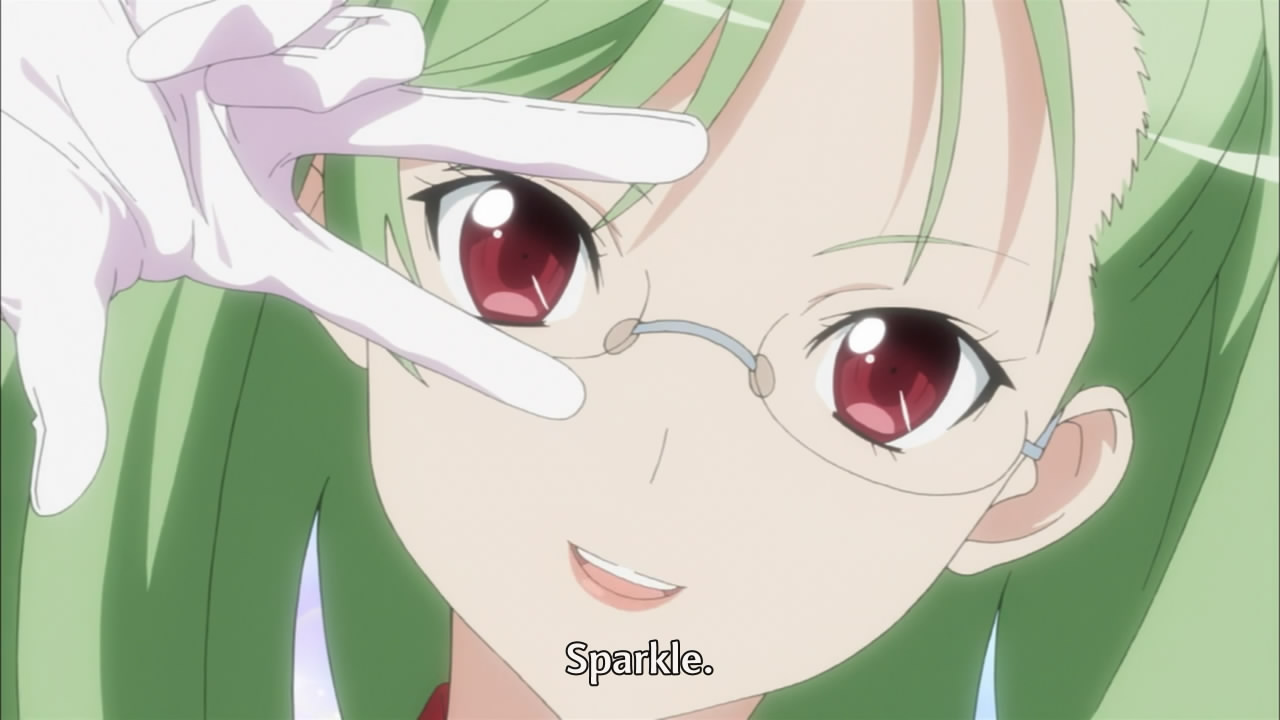
"Sparkle." (10:13)
The Japanese line is "Kira!" (キラッ!). This is an onomatopoeia for something sparkling or glittering. It is also famously said aloud by Ranka Lee while singing "Seikan Hikou" (星間飛行), "Interstellar Flight", in episode 12 of "Macross Frontier" (マクロスF), an anime series that aired in 2008.S2
On a related note, the pose that Luhy is doing is a fairly common pose in anime and games. Its exact origin is unclear, but some well known examples include:
Sailor Moon from "Sailor Moon". Sailor Moon's Make Up pose from the 1992 anime adaptation:
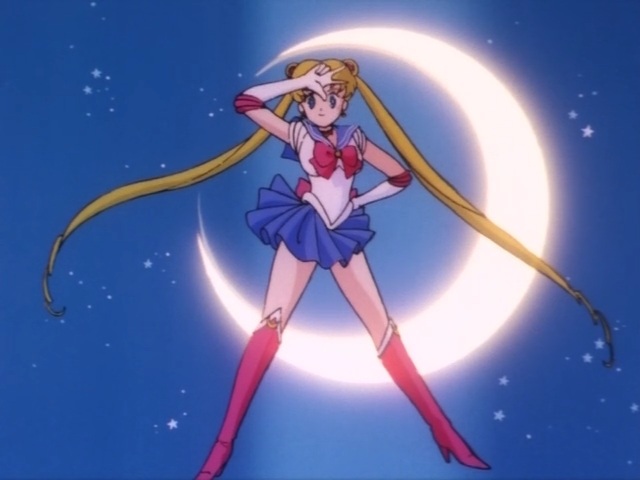
Asamiya Athena from "The King of Fighters" game series. Official art from "The King of Fighters '96":
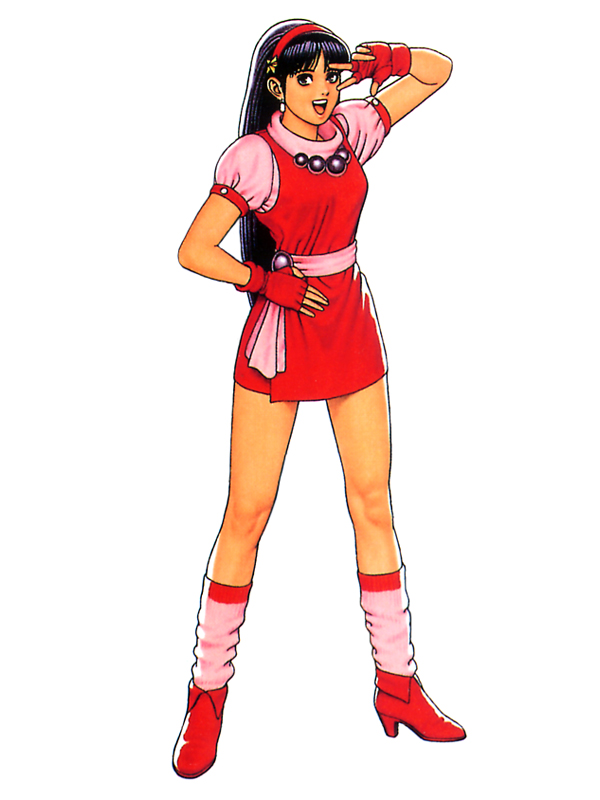
Source of image: http://snk.wikia.com/wiki/File:Athena96.jpg
A more recent usage of this pose was in "Star Driver" (STAR DRIVER 輝きのタクト), an anime series that aired from 2010 to 2011. In the series, members of the Glittering Star Crux Brigade (綺羅星十字団 Kiraboshi Juuji Dan) make this pose and say the phrase "Kiraboshi" (綺羅星), "Glittering star", when greeting one another. Image for reference:
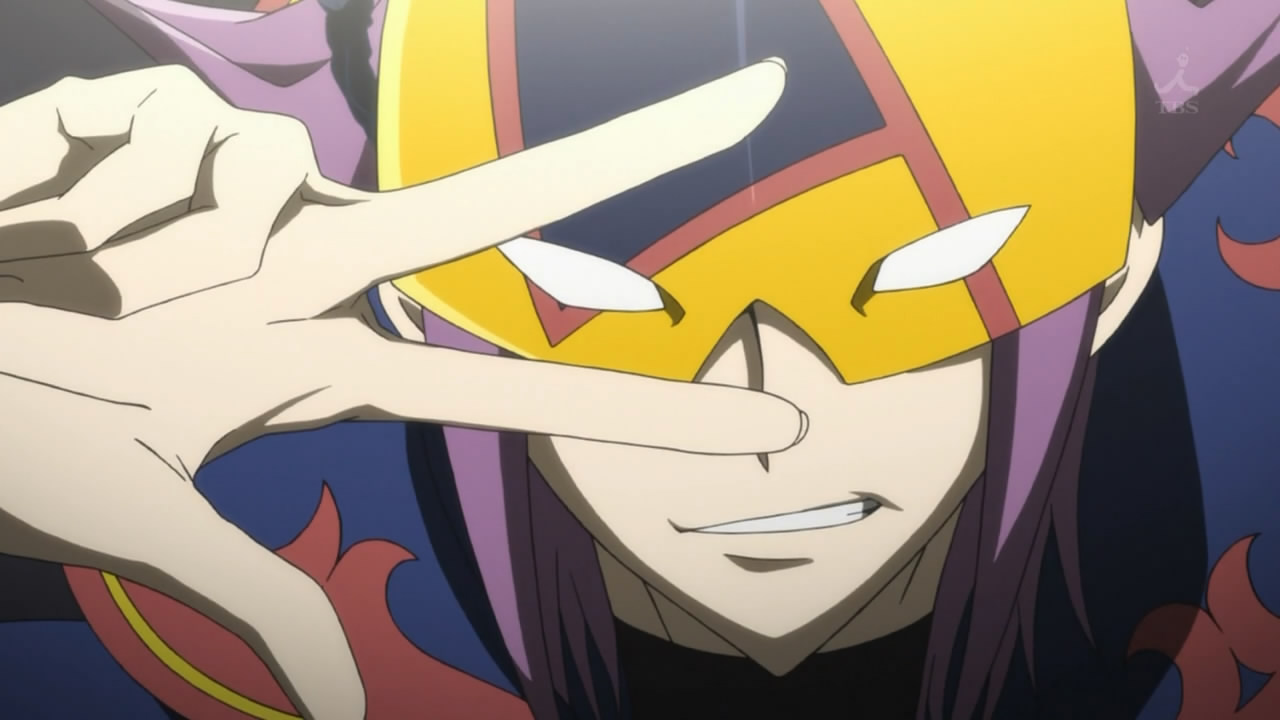
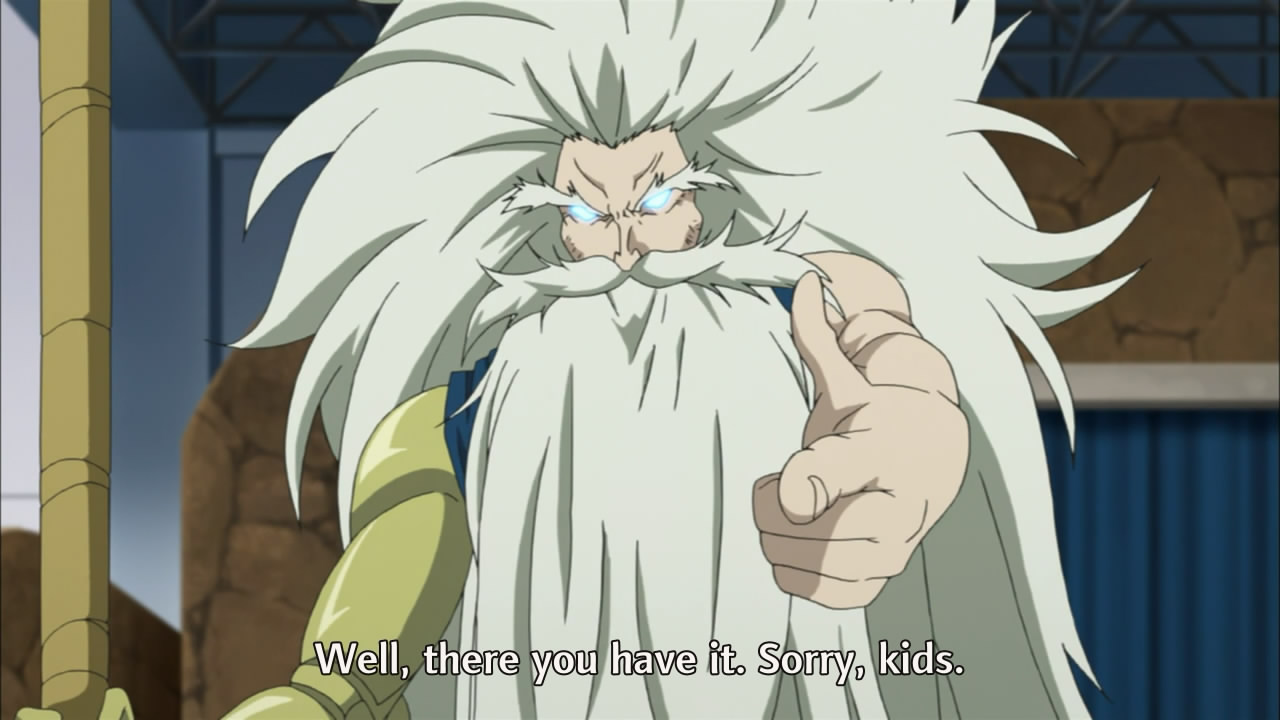
"Well, there you have it. Sorry, kids." (10:32)
The Japanese line is "Sou iu koto da. Sumanai, kodomo-tachi" (そういう事だ。すまない、子供達). This is referencing a line said by Paptimus Scirocco in episode 46 of "Mobile Suit Zeta Gundam" (機動戦士Ζガンダム).S2 His original line goes, "Sou iu koto da. Sumanai, Jamitofu" (そういうことだ。すまない、ジャミトフ), which translates to "That's how it is. I'm sorry, Jamitov". Nodens pointing his finger is referencing how Scirocco is pointing a gun at Jamitov when he says this line. Again, this is referencing how the voice actor who voices Nodens, Shimada Bin (島田敏), also voices Paptimus.
"Staff! Staff!" (10:36)
The Japanese line is "Sutafuuu, sutafuuu" (スタッフゥー、スタッフゥー). This is referencing the same line said by the Japanese comedian Kino Eikou (狩野英孝) as one of his trademark gags.S2
"She must have gone to some temple and changed her job from takoyaki vendor to magical girl." (10:45)
This is referencing the Temple of Dharma (ダーマ神殿) from "Dragon Quest III" (ドラゴンクエストIII), a video game released in 1988.S1 At the temple, a character in the player's party can change classes, excluding the hero character.
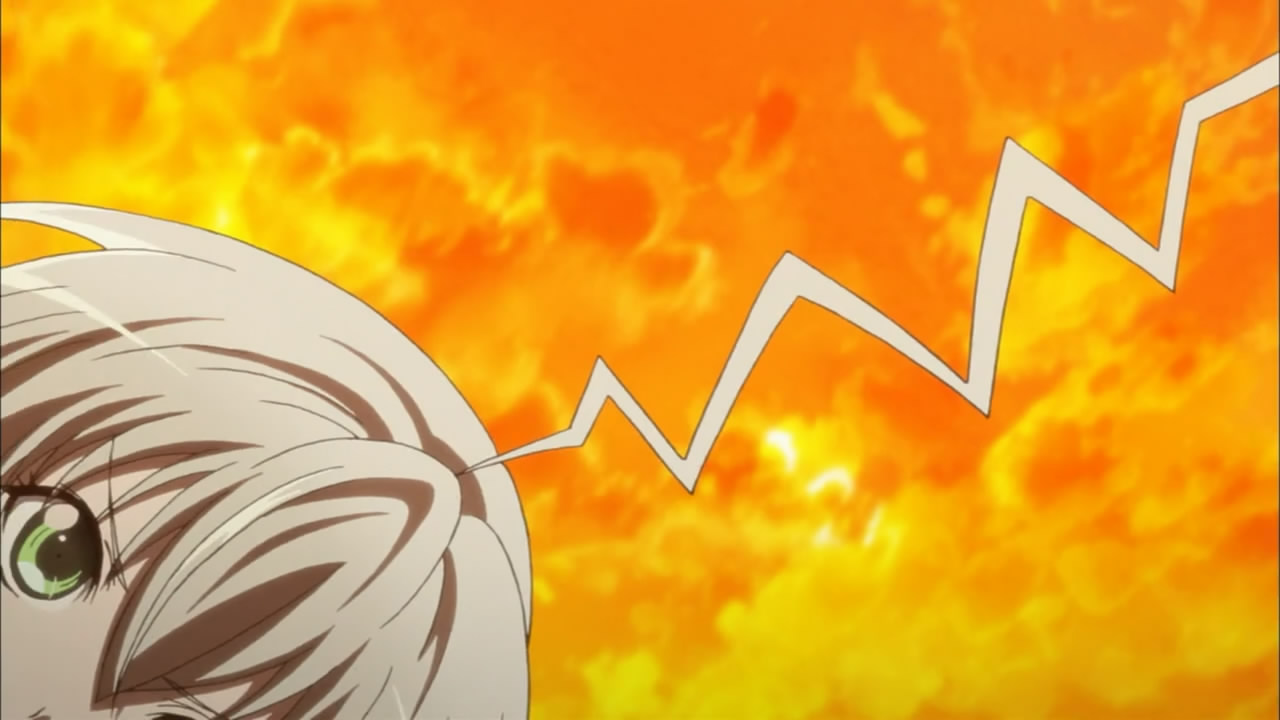
(11:00)
This is Nyaruko's "Jashin Reedaa" (邪神レーダー), "Evil God Radar". It first appeared in episode 2 at 6:37. This is referencing Kitarou (鬼太郎) from "GeGeGe no Kitarou" (ゲゲゲの鬼太郎), a manga series written by Mizuki Shigeru (水木しげる) and first published from 1960 to 1969. In the series Kitarou has an ability called "Yokai Antena" (妖怪アンテナ) that uses his hair to detect youkai or spiritual activity. When Kitarou's hair detects activity a strand of his hair sticks up.
"I am of the Great Race of Yith!" (11:10)
There are two references here:
* The Great Race of Yith is a race of creature in the Cthulhu Mythos that migrated to Earth from their home planet of Yith and first appeared in "The Shadow Out of Time", a story written by H. P. Lovecraft and first published in 1936.
* The Japanese line is "Watashi ha iisu no idai naru shuzoku. Chikyuu ha nerawarete iru desu yo!" (私はイースの偉大なる種族。地球は狙われているですョ!). This is referencing a line said by Eiji Asuka from "Aoki Ryuusei SPT Reizunaa" (蒼き流星SPTレイズナー), "Blue Comet SPT Layzner", an anime series that aired from 1985 to 1986. His line goes "Boku no na ha Eiji, chikyuu ha nerawarete iru!" (僕の名はエイジ、地球は狙われている!), which translates to "My name is Eiji, the Earth is being targetted!".S1
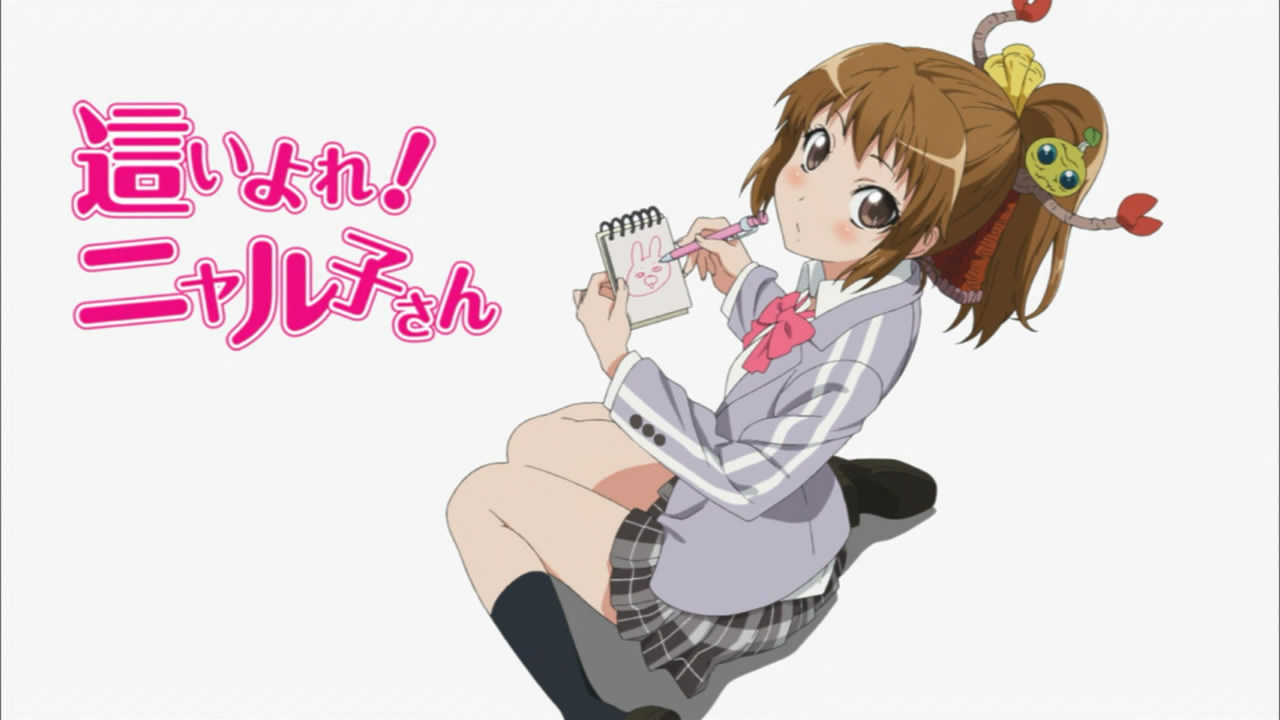
(12:02)
There are two references here:
* The rabbit drawn on the notepad was drawn by Tamao's voice actor, Ootsubo Yuka (大坪由佳).S3 She drew it on March 3, 2012 during the first "Nico Nyaru" (ニコニャル), a series of live broadcasts promoting the "Haiyore! Nyaruko-san" anime. Image for reference:
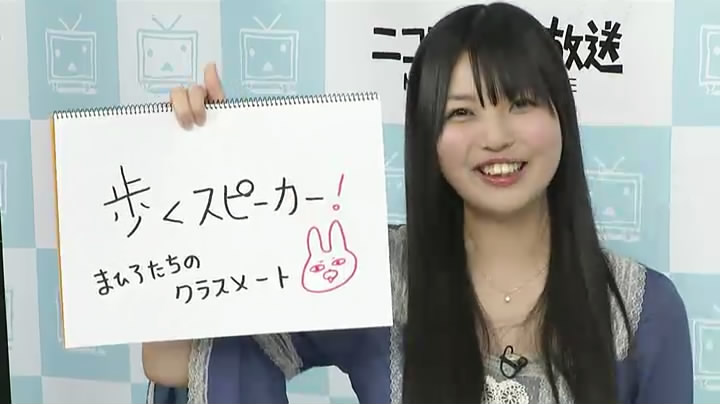
Video for reference: http://www.nicovideo.jp/watch/sm17339671
* The creature in Tamao's hair is a creature of the Great Race of Yith. In "The Shadow Out of Time", a story written by H. P. Lovecraft and first published in 1936, they are described as follows:
"They seemed to be enormous iridescent cones, about ten feet high and ten feet wide at the base, and made up of some ridgy, scaly, semi-elastic matter. From their apexes projected four flexible, cylindrical members, each a foot thick, and of a ridgy substance like that of the cones themselves. These members were sometimes contracted almost to nothing, and sometimes extended to any distance up to about ten feet. Terminating two of them were enormous claws or nippers. At the end of a third were four red, trumpet-like appendages. The fourth terminated in an irregular yellowish globe some two feet in diameter and having three great dark eyes ranged along its central circumference. Surmounting this head were four slender grey stalks bearing flower-like appendages, whilst from its nether side dangled eight greenish antennae or tentacles. The great base of the central cone was fringed with a rubbery, grey substance which moved the whole entity through expansion and contraction."The cover of the June 1936 issue of "Astounding Stories", the magazine in which Lovecraft first published "The Shadow Out of Time", has an illustration of the Great Race of Yith:
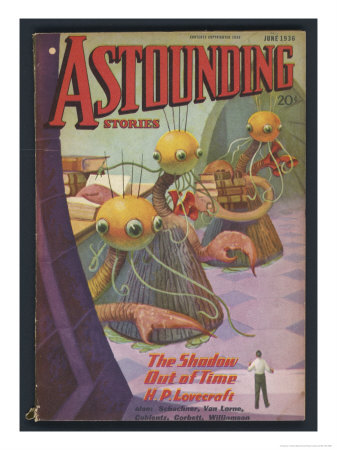
Source of image: https://en.wikipedia.org/wiki/File:ShadowOutOfTime.jpg
"This is Yithka. She came to our time by projecting her mind from another timeplane. She said she's borrowing Tamao's body, or something." (12:16)
This character is Isuka (イス香), Yithka. She is based on creatures belonging to the Great Race of Yith in the Cthulhu Mythos. In "The Shadow Out of Time", a story written by H. P. Lovecraft and first published in 1936, they are described as follows:
"This, they indicated, was the greatest race of all; because it alone had conquered the secret of time. It had learned all things that ever were known or ever would be known on the earth, through the power of its keener minds to project themselves into the past and future, even through gulfs of millions of years, and study the lore of every age."A creature of the Great Race of Yith can travel through time by switching its mind with the mind of a creature in another time period. In "The Shadow Out of Time", this method of time travel is described as follows:
"With suitable mechanical aid a mind would project itself forward in time, feeling its dim, extra-sensory way till it approached the desired period. Then, after preliminary trials, it would seize on the best discoverable representative of the highest of that period’s life-forms; entering the organism’s brain and setting up therein its own vibrations while the displaced mind would strike back to the period of the displacer, remaining in the latter’s body till a reverse process was set up. The projected mind, in the body of the organism of the future, would then pose as a member of the race whose outward form it wore; learning as quickly as possible all that could be learned of the chosen age and its massed information and techniques."
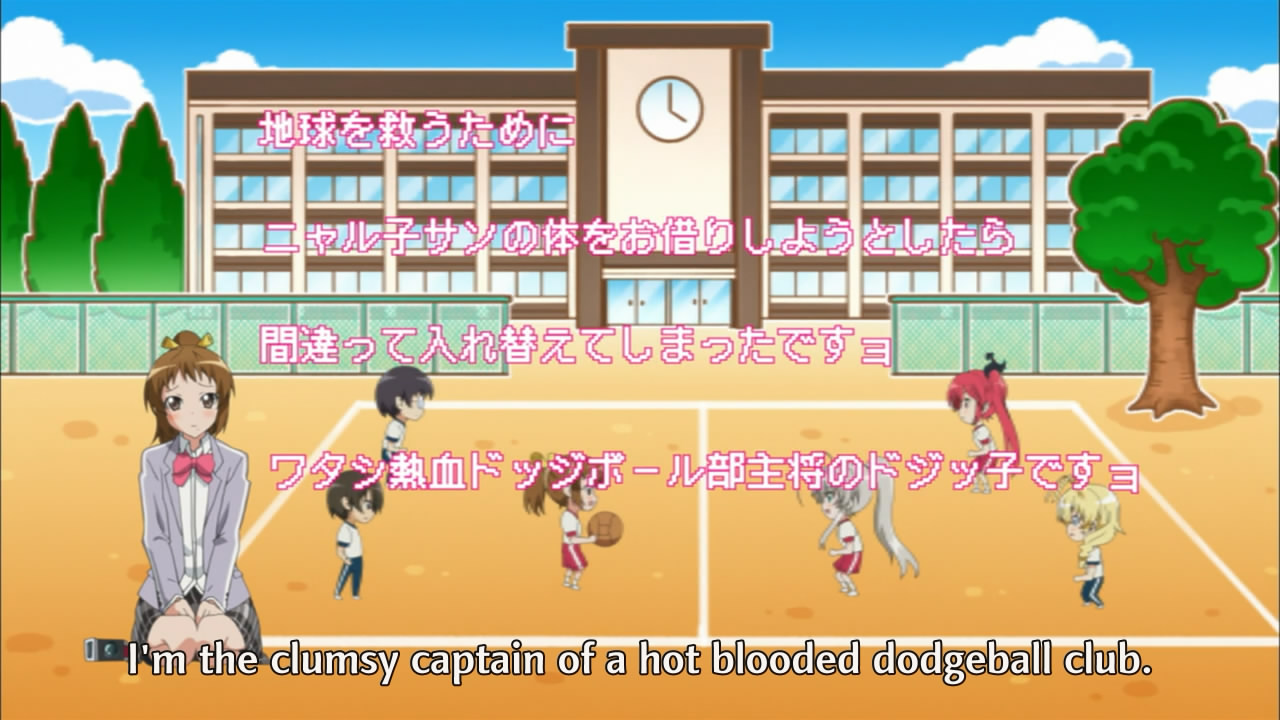
"I'm the clumsy captain of a hot blooded dodgeball club." (12:39)
There are two references here:
* The Japanese line is "Watashi nekketsu dojjibooru bu shushou no dojikko desu yo" (ワタシ熱血ドッジボール部主将のドジっ子ですョ). This is referencing "Nekketsu Koukou Dojjibooru Bu" (熱血高校ドッジボール部), "Hot Blooded High School Dodgeball Club", a video game released in 1987.S1 The background image of the cast playing dodgeball is also based on the game. Image for reference:

* Yithka's speaking habit of ending her sentences with a small "yo" (ョ), is referencing the same habit of Matsukura Ai (松倉藍) from the visual novel "Hateshinaku Aoi, Kono Sora no Shita de..." (果てしなく青い、この空の下で…。), "Beneath This Eternally Blue Sky...", released by TOPCAT in 2000. Ai will often add a small "yo" (ょ) to the ends of words during her lines. However, the decisive connection between Yithka and Ai is that Ai is also a character whose body is possessed by an alien being. In addition, only while Ai is possessed does she have this speaking habit, just like how only Yithka has this habit, not Tamao. Furthermore, the name of the being that possesses Ai is Izu=Houtorya (イズ=ホゥトリャ), Yzz=HwTrrra, which is similar to "Iisu" (イース), the Japanese spelling of "Yith". To note, Yzz=HwTrrra is not a being from the Cthulhu Mythos and "Hateshinaku Aoi, Kono Sora no Shita de..." does not use any explicit Cthulhu Mythos terminology. However, like with Yzz=HwTrrra, there are various Cthulhu Mythos inspired elements in the game. Also, in the official guide book for the game (果てしなく青い、この空の下で...。公式ビジュアルブック), released in 2000, the scenario writer of the game, Takatori Hyouma (鷹取兵馬), mentioned the following:
「その中の作品の一つが、昔自分が読んだことのあるラヴクラフトの小説の展開に似ていて、あ、これはいいかも。と閃きました。」Scan provided by servitors for reference. Here is an example of one of Ai's lines with her signature "yo":
One of the works I read a long time ago had developments similar to that of Lovecraft's novels, and I thought, "Ah, this might be good", and was hit by inspiration.
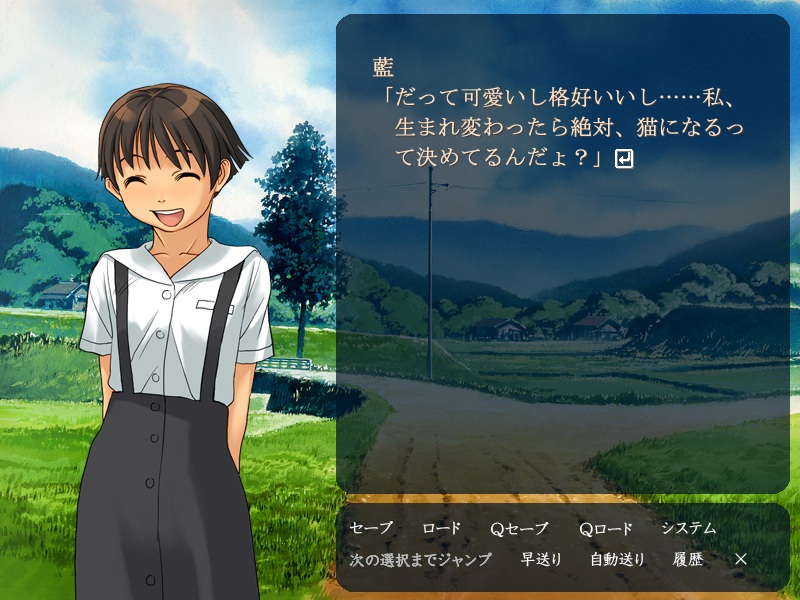
In addition, Yithka's speaking habit is originally present in the "Haiyore! Nyaruko-san" light novel series, starting with when she first appears in chapter 1 of volume 3.S5 Many thanks to servitors for explaining this very hard to notice reference.
"Of montrous course I can" (12:50)
The Japanese line is "Kaijuu mochi no ron desu yo" (怪獣モチのロンですョ). This is a pun combining the Japanese phrase "Mochiron desu" (もちろんです), which means "of course", and "Kaijuu Mochiron" (怪獣モチロン), the name of a monster that appeared in episode 39 of "Ultraman Taro".S1
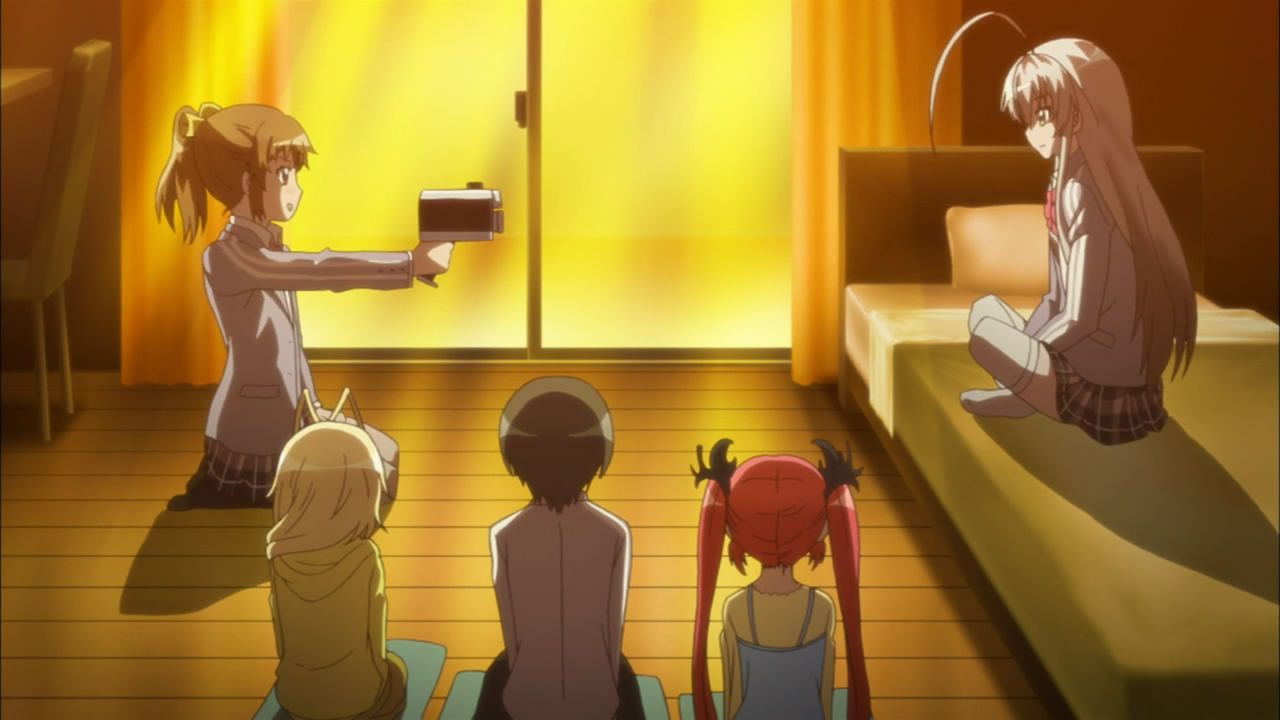
(12:52)
The camera-like device that Yithka uses is referencing how creatures of the Great Race of Yith use "camera-like weapons which produced tremendous electrical effects" as stated in "The Shadow Out of Time", a story written by H. P. Lovecraft and first published in 1936.
"I'll never forgive you! Never!" (13:05)
The Japanese line is "Zettai ni yurusanai! Zettai ni da!" (絶対に許さない!絶対にだ!). This is a popular line used on Japanese message boards in response to posters who have improper conduct or make mistakes. However, most of the time the line isn't meant to be taken seriously.S1
"The Great Race of Yith lives to acquire knowledge. We'd sprout tentacles from our throats to get our hands on the entertainment produced in this period of Earth's history." (13:09)
In the Cthulhu Mythos, the Great Race of Yith is a very intelligent race and has a great thirst for knowledge. In "The Shadow Out of Time", a story written by H. P. Lovecraft and first published in 1936, they are described as follows:
"In its vast libraries were volumes of texts and pictures holding the whole of earth's annals—histories and descriptions of every species that had ever been or that ever would be, with full records of their arts, their achievements, their languages, and their psychologies. With this aeon-embracing knowledge, the Great Race chose from every era and life-form such thoughts, arts, and processes as might suit its own nature and situation."
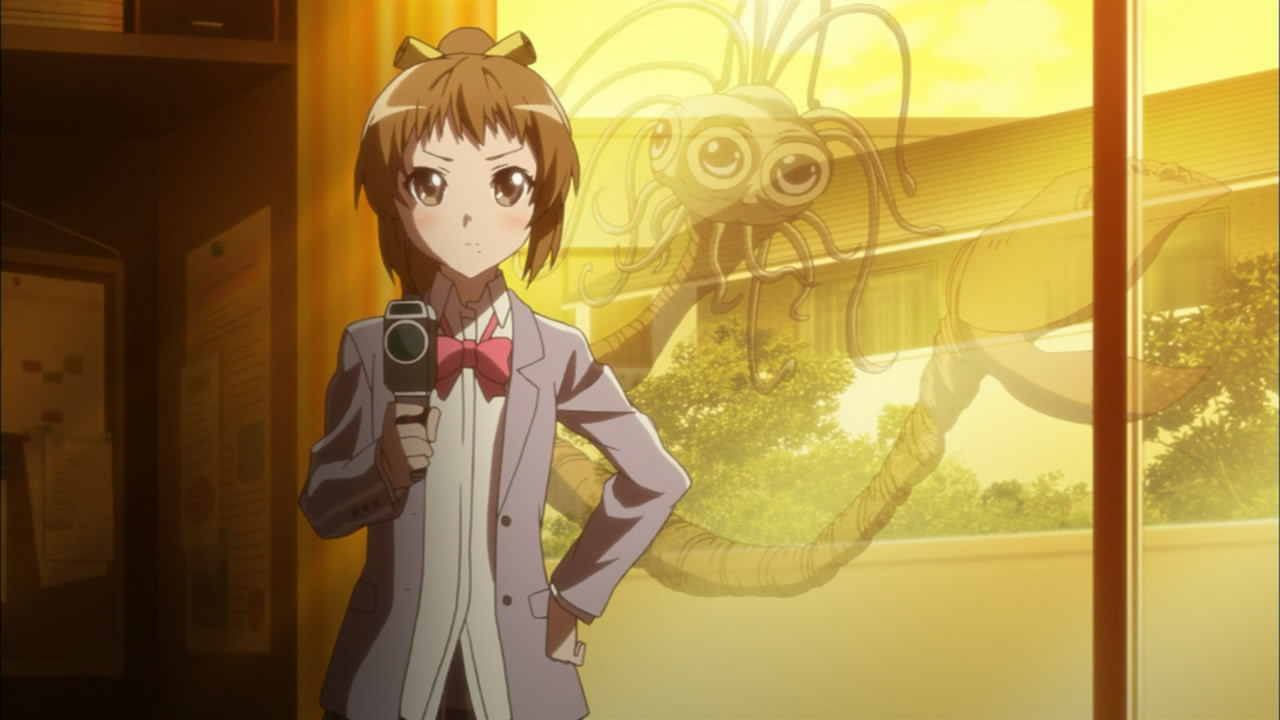
(13:21)
The creature that appears as a reflection in the glass is a creature of the Great Race of Yith with only its head and one claw visible.
(14:21)
The line at this time goes as follows:
「それでは私は説明が終わった解説キャラのようにオイトマンするですョ」The phrase "oitoman suru desu yo" (オイトマンするですョ) more literally translates to "I will now oitoman". The term "oitoman" (オイトマン) is used by Kurama Kiddo TenguTengu (クラマ・キッド・テングテング) in "The MOMOTAROH" (ザ・モモタロウ), a manga series written by Niwano Makoto (にわのまこと) and published from 1987 to 1989. Image for reference:
"Sore de ha watashi ha setsumei ga owatta kaisetsu kyara no you ni oitoman suru desu yo"
"Well, now that I have finished my explanation like any expository character, time for me to exit, stage left!"
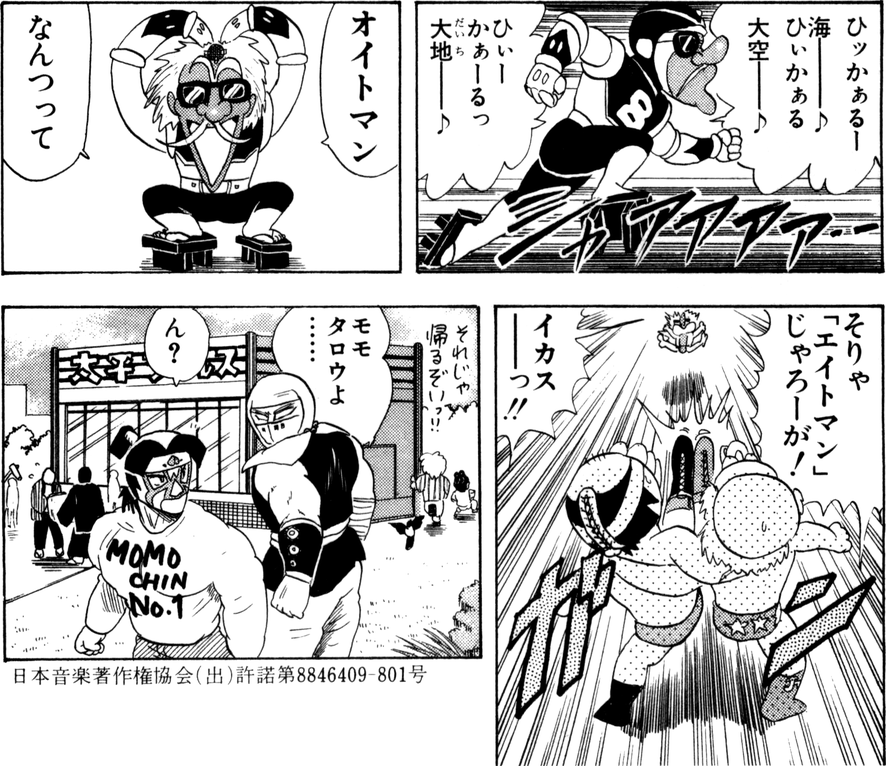
In addition, as can be seen in the above image, "oitoman" (オイトマン) is a parody of "Eitoman" (エイトマン), "8 Man". 8 Man is a super hero android from "Eitoman" (8マン), "8 Man", a manga series written by Hirai Kazumasa (平井和正) and published from 1963 to 1966.S2
"You should learn some delicacy." (15:26)
The Japanese line is "Onna no ko nan desu kara, mou chotto derikashii to iu mono wo" (女の子なんですから、もうちょっとデリカシーというものを). The word "derikashii" (デリカシー), "delicacy", is often used by Takanashi Miu (小鳥遊美羽) in "Papa no Iu Koto wo Kikinasai!" (パパのいうことを聞きなさい!), "Listen to Me, Girls. I Am Your Father!", a light novel series written by Matsu Tomohiro (松智洋) and published starting from 2009. On a related note, the voice actor who voices Mahiro, Kitamura Eri (喜多村英梨), also voices Miu in the anime adaptation of this series that aired in 2012.S1

(16:55)
The rainbow colored effect surrounding Nyaruko is referencing the same effect used in the game "Duel Love", released in 2008. The story of the game concerns a female protagonist who becomes friends with the male members of her high school's boxing club. There are various mini games in which the player takes care of a guy's body, such as treating post-fight scrapes and bruises or giving him a backrub. While playing one of these games, the guy's condition is indicated by his facial expression and the background's appearance. When the guy's condition is at the highest level, "Heven Joutai" (ヘヴン状態), "Heaven Condition", the background turns rainbow colored.S1 Image of the various statuses for reference:
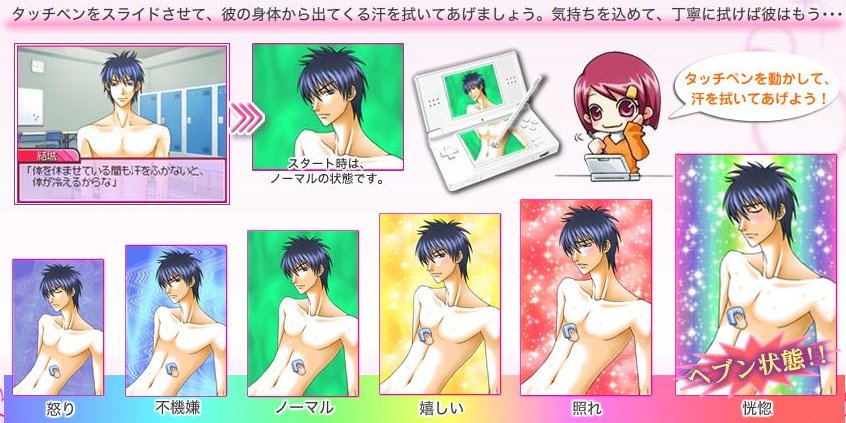
Source of image: http://jin115.com/archives/51231925.html
Video for reference: https://youtu.be/z3YxRG-52T4?t=1m16s
"Boys really are great." (17:19)
The Japanese line is "Iyaa, otokonoko tte hontou ni ii mono desu ne" (いやぁ、男の子って本当にいいものですね). This is referencing the Japanese film critic Mizuno Haruo (水野晴郎) who once said, "Iyaa, eiga tte hontou ni ii mon desu ne" (いやぁ、映画って本当にいいもんですね), which translates to "Ahh, movies really are great".S2
"I will allow you to have this piece of paper." (19:26)
The Japanese line is "Kono kami wo shoyuu suru kenri wo yarou" (この紙を所有する権利をやろう). This more literally translates to "I will give you the right to own this paper". This is referencing a popular Japanese net phrase "Houbi toshite opuuna wo kau kenri wo yarou" (褒美としてオプーナを買う権利をやろう), which translates to "As a reward I will give you the right to buy Opoona". This phrase is typically accomanpied by Yaruopuuna (やるオプーナ), an ASCII art character created on the Japanese message board 2channel. "Opoona" (オプーナ opuuna) is a game for the Nintendo Wii that was published by Koei in 2007. The appearance of Yaruopuuna is based on that of another ASCII art character created on 2ch, Yaruo (やる夫), and the main character of "Opuuna", Opuuna.S2 Here is a typical image of Yaruopuuna and the accompanying line for reference:
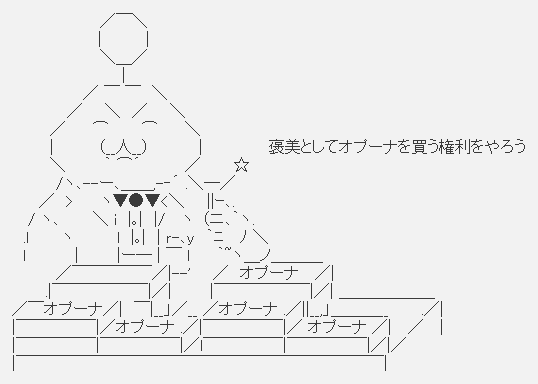
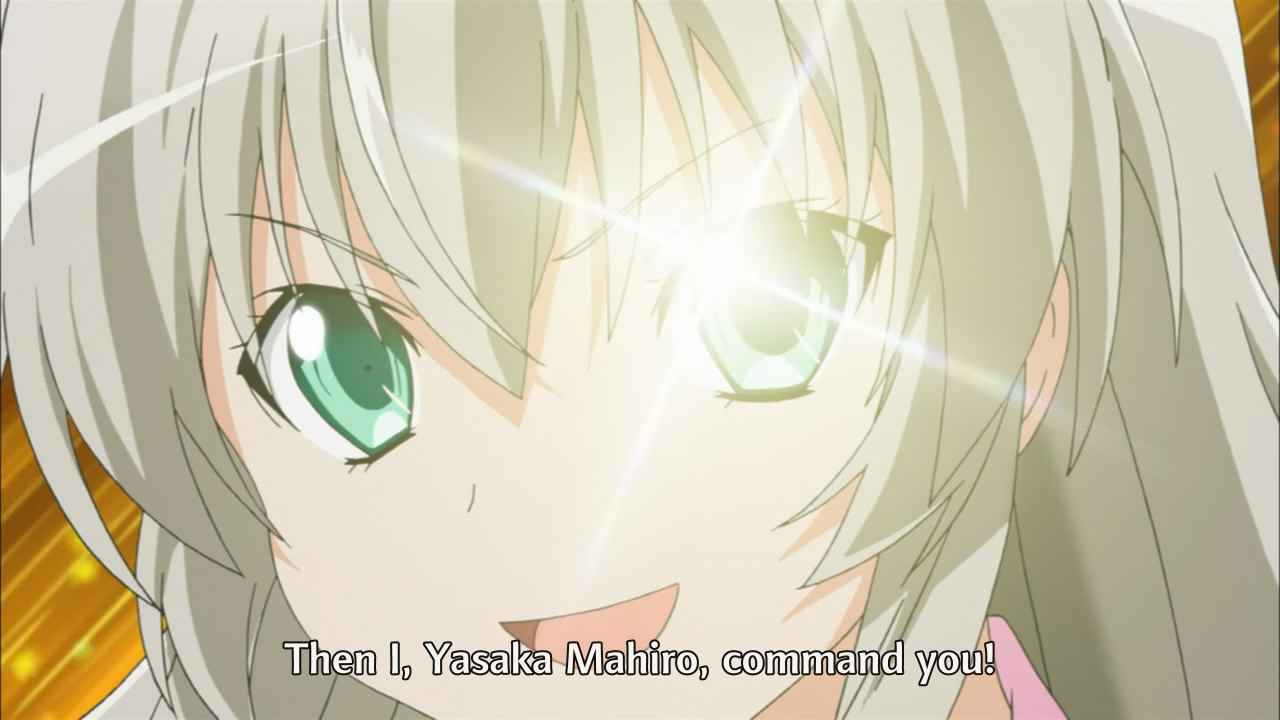
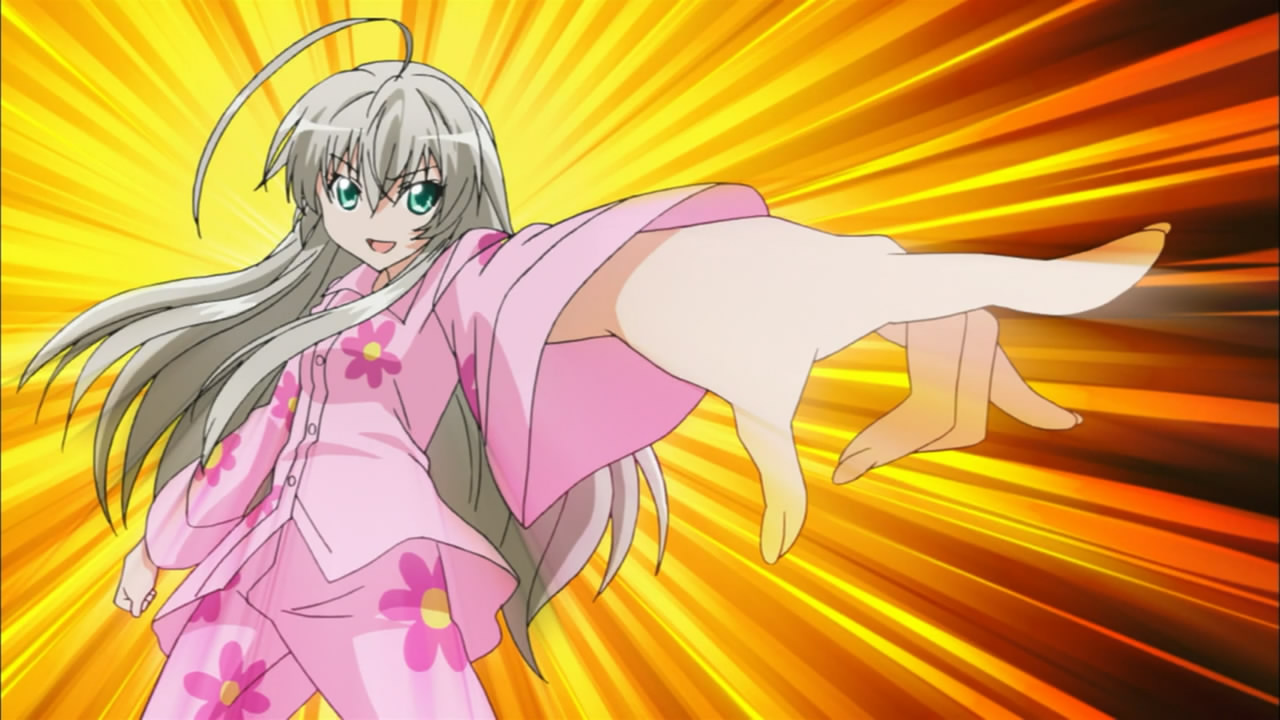
"Then I, Yasaka Mahiro, command you!" (19:53)
There are three references here:
* The Japanese line is "De ha, Yasaka Mahiro ga Kuuko ni meijiru! (では、八坂真尋がクー子に命じる!). This is referencing a line said by Lelouch Lamperouge (ルルーシュ・ランペルージ) in "CODE GEASS Lelouch of the Rebellion" (コードギアス 反逆のルルーシュ), an anime series that aired from 2006 to 2007. His line goes, "Ruruushu Vi Buritania ga meijiru" (ルルーシュ・ヴィ・ブリタニアが命じる), which translates to "I, Lelouch Vi Britannia, command you!".
* The flashing effect on Mahiro's left eye is referencing Lelouch's special ability to cast a magic spell from his left eye, Geass, that forces those who see it to obey Lelouch's command.S1
* Mahiro's pointing pose is also mimicking that of Lelouch when he issues commands. Images for reference:
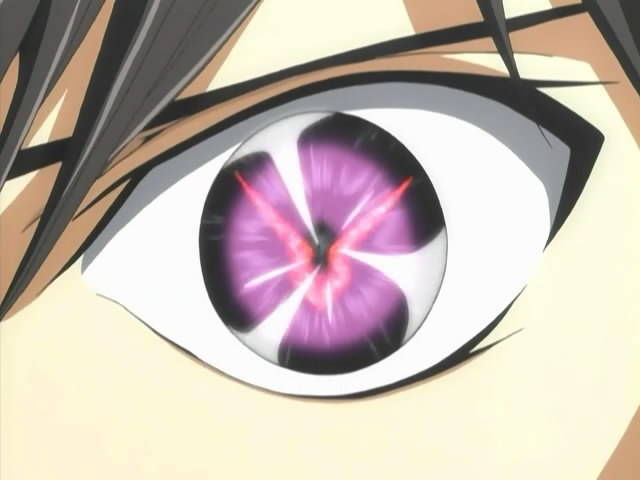
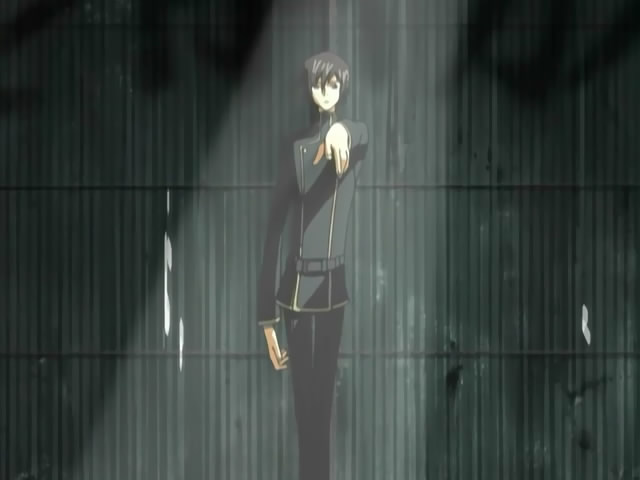
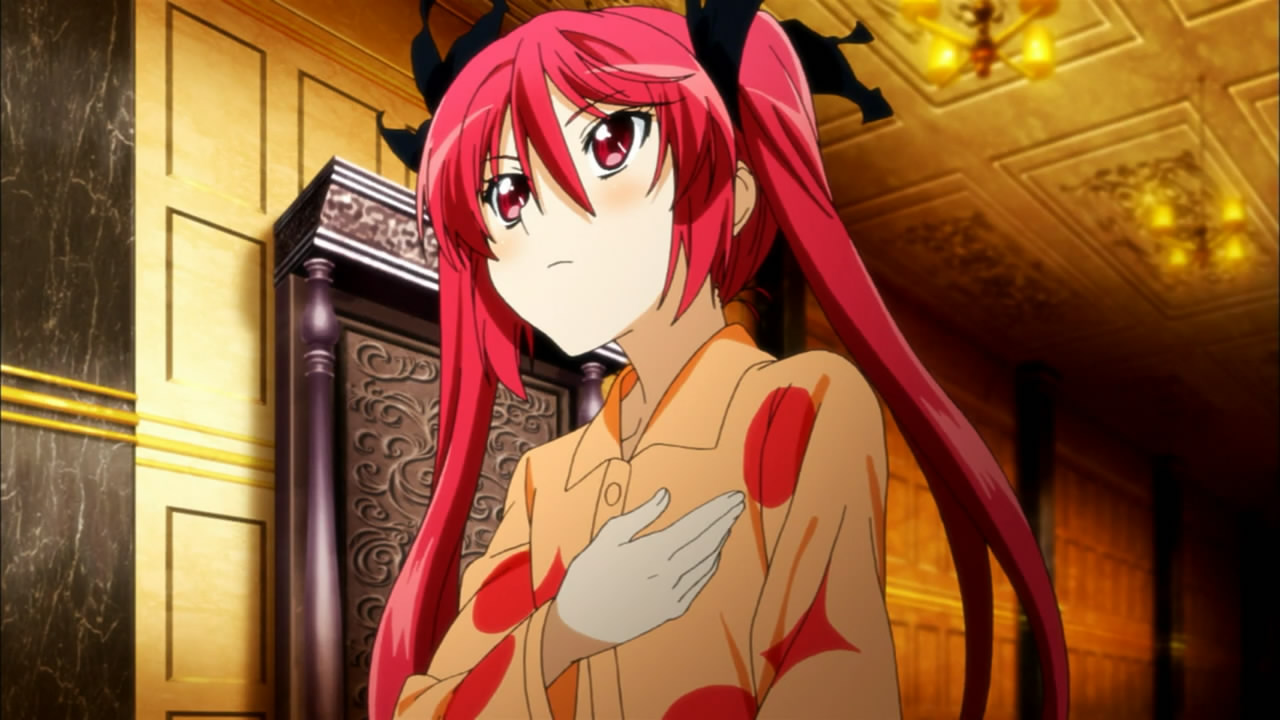
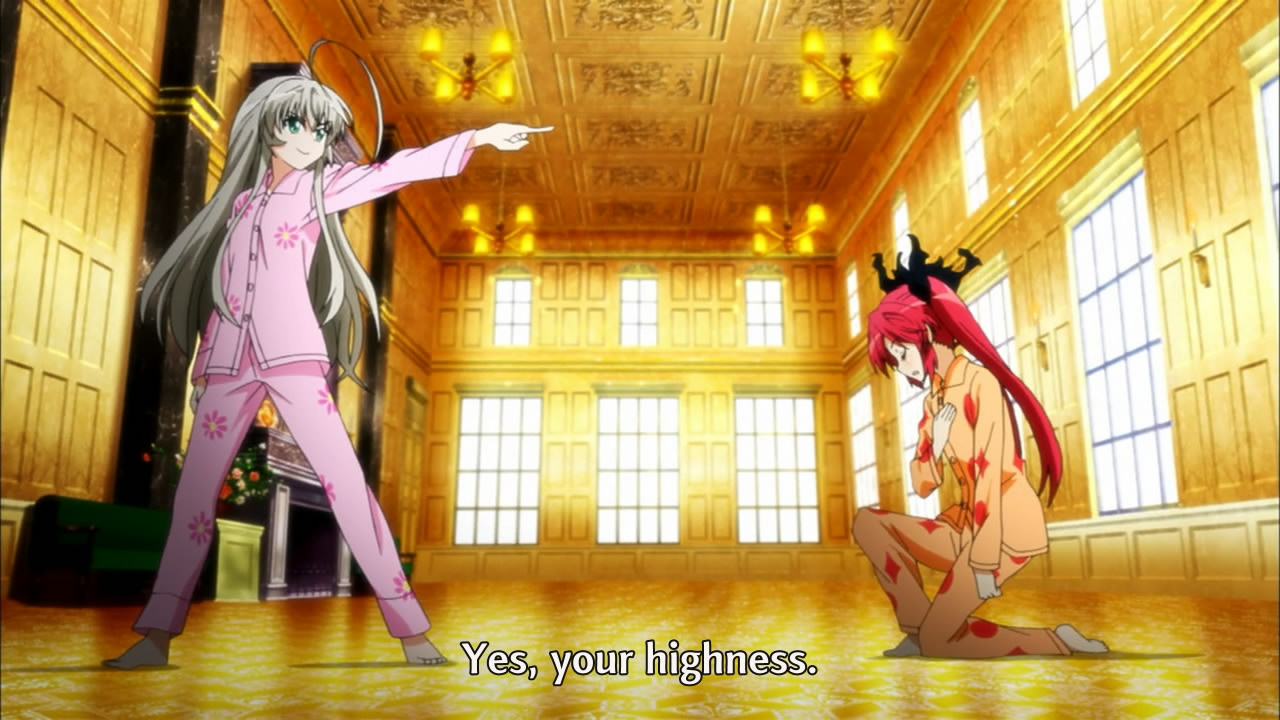
"Yes, your highness." (20:02)
Cthuko's posing, bowing on one knee with one arm across the chest, and line are both used when addressing royalty in "CODE GEASS Lelouch of the Rebellion" (コードギアス 反逆のルルーシュ). Image for reference:
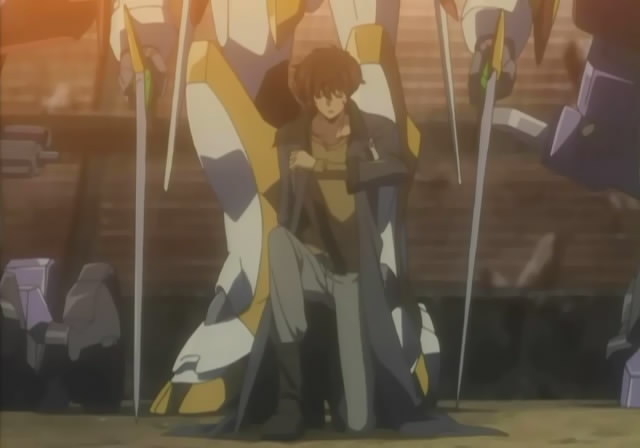
(20:47)
The line at this time goes as follows:
「フォークを刺されるぐらい怖がらなくてもいいじゃないか。安心しろよ、ニャル子」This is referencing a line said by Dio Brando (ディオ・ブランドー) in chapter 252 in volume 27 of "Jojo no Kimyou na Bouken" (ジョジョの奇妙な冒険), "Jojo's Bizarre Adventure", a manga series written by Araki Hirohiko (荒木飛呂彦) and published starting from 1987.S2 The original line goes as follows:
"Fooku wo sasareru gurai kowagaranakute mo ii ja nai ka. Anshin shiro yo, Nyaruko"
"You don't have to be so scared that you'll be stabbed with a fork. Relax, Nyaruko."
『ゲロを吐くぐらいこわがらなくてもいいじゃあないか・・・安心しろ・・・安心しろよ・・・花京院』Image for reference:
"Gero wo haku gurai kowagaranakute mo ii jaa nai ka... Anshin shiro... Anshin shiro yo... Kakyouin"
"You don't have to be so scared of me that you'll throw up... Relax... Relax... Kakyouin"
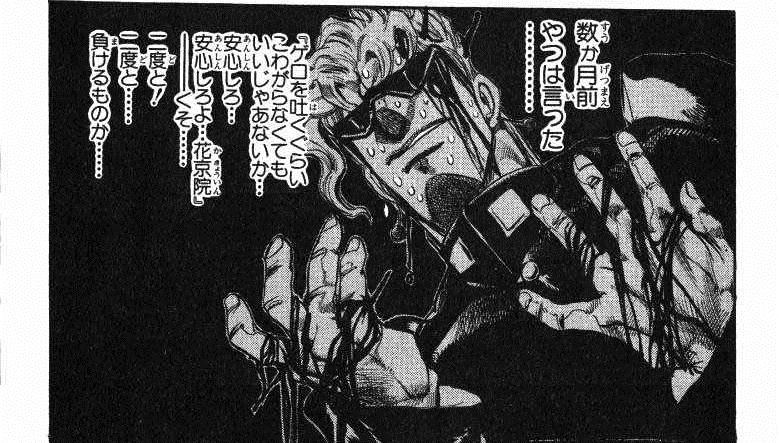
"I'll correct that kind of adult!" (23:41)
The Japanese line is "Sonna otona, shuusei shite yaru!" (そんな大人、修正してやる!). This is referencing the same line said by Kamille Bidan (カミーユ・ビダン) in episode 13 of "Mobile Suit Zeta Gundam" (機動戦士Ζガンダム).S1 Video for reference: https://youtube.com/watch?v=3w6uyU3t_oQ
"This vulgar person!" (23:42)
The Japanese line is "Kono zokubutsu ga!" (この俗物が!). The term "zokubutsu" (俗物), "vulgar person", is referencing Haman Karn (ハマーン・カーン) from "Mobile Suit Zeta Gundam" (機動戦士Ζガンダム).S1 In the series, Haman uses this term to disparage others.
"I'll aim and shoot!" (23:43)
The Japanese line is "Nerai utsu ze!" (狙い撃つぜ!). This is a catch phrase said by Neil Dylandy (ニール・ディランディ), also known as Lockon Stratos (ロックオン・ストラトス), in "Mobile Suit Gundam 00" (機動戦士ガンダム00), an anime series that aired from 2007 to 2008.S1
"Pilder..." (23:51)
The Japanese line is "Pairudaa" (パイルダー). What Nyaruko was about to say before Mahiro interrupts is "Pairudaa On!" (パイルダー・オン), "Pilder On!". This is a catch phrase said by Kabuto Kouji (兜甲児) in "Mazinger Z" (マジンガーZ), an anime series that aired from 1972 to 1974.S1
"I was so stupid!" (23:52)
The Japanese line is "Atashi tte, honto baka!" (あたしって、ほんとバカ!). This is referencing the same line said by Miki Sayaka (美樹さやか) in episode 8 of "Mahou Shoujo Madoka Magika" (魔法少女まどか☆マギカ), "Magical Girl Madoka Magica", an anime series that aired in 2011.S1 This line is also the title of episode 8 of this series.S3 On a related note, the voice actor who voices Mahiro, Kitamura Eri (喜多村 英梨), also voices Sayaka.
List of sources:
S1. Comments on this post
S2. A post at Steman Blog (ステマブログ)
S3. Japanese Nyaruko References Wiki (這いよれ! ニャル子さん 元ネタwiki) - Nyaruko Episode 9
S4. A blog by servitors about Cthulhu Mythos inspired works (クトゥルー/クトゥルフ神話作品発掘記)
S5. Japanese Nyaruko References Wiki (這いよれ! ニャル子さん 元ネタwiki) - Nyaruko Light Novel Series Volume 3, Chapter 1
Thanks to everyone who contributed! This list wouldn't be nearly as long without you all. See you next episode!
情報を教えてくださって本当にありがとうございました!皆さんがいなかったら、このリストはぜんぜん長くありません。またこの次までね!
Last updated July 1, 2012
Sitemap
Home
